The word “abstract” means something that is theoretical in nature.
It’s not meant to look stunning but to deliver a message to the viewer.
To an ordinary eye, it might seem vague and incomplete. That is because of the absence of a subject, which makes it unapologetically hypothetical.
One of the main philosophies of abstract art is that reality is not concrete but subjective.
Therefore, it is the viewer who defines the painting. Which is why it is also called “thinkers’ painting.”
Wassily Kandinsky created a new chapter in the history of painting by introducing the genre in 1911, which was relatively new to the painting world.
This brought on a new era of paintings, whose ideology was up to the interpretation of the viewer.
Still, it attracted millions of inquiring eyes who were hell-bent on figuring out the hidden meaning behind each brush stroke.
Keep scrolling and you will find our list of famous abstract paintings that ruled the hearts of art viewers.
Table of contents
- 1. Windows Open Simultaneously (1912)
- 2. Composition VII (1913)
- 3. Improvisation 31 (Sea Battle) (1913)
- 4. Electric Prisms (1914)
- 5. Black Square (1915)
- 6. The Swan, No. 17( 1915)
- 7. Suprematist Composition (1916)
- 8. White on White (1918)
- 9. Tableau I (1921)
- 10. Blue and Green Music (1921)
- 11. Senecio (1922)
- 12. Twittering Machine (1922)
- 13. La Mancha Roja (1925)
- 14. Composition II (1930)
- 15. 1934 relief (1934)
- 16. Death and Fire (1940)
- 17. Broadway Boogie Woogie (1943)
- 18. Full Fathom Five (1947)
- 19. White Center (Yellow, Pink, and Lavender on Rose.) (1950)
- 20. Autumn Rhythm Number 30. (1950)
- 21. One Number 31 (1950)
- 22. Red (1952)
- 23. Mountains and Sea (1952)
- 24. Convergence (1952)
- 25. Woman III (1953)
- 26. No. 61 Rust and Blue (1953)
- 27. Interchange (1955)
- 28. False Start (1959)
- 29. Orange, Red, Yellow (1961)
- 30. Leda and the Swan (1962)
- 31. Peinture (Etoile Bleue) (1963)
- 32. Triptych Bleu I, II, III
- 33. No.5 (1962)
- 34. Elegy to the Spanish Republic (1967)
- 35. 180 Farben (1971)
- 36. On A Clear Day (1973)
- 37. Juin-Octobre (1985)
- 38. Abstrakte Bild 809-1 (1994)
- 39. Small flies and Other Wings (2013)
- 40. Slit (2020)
- FAQs
1. Windows Open Simultaneously (1912)
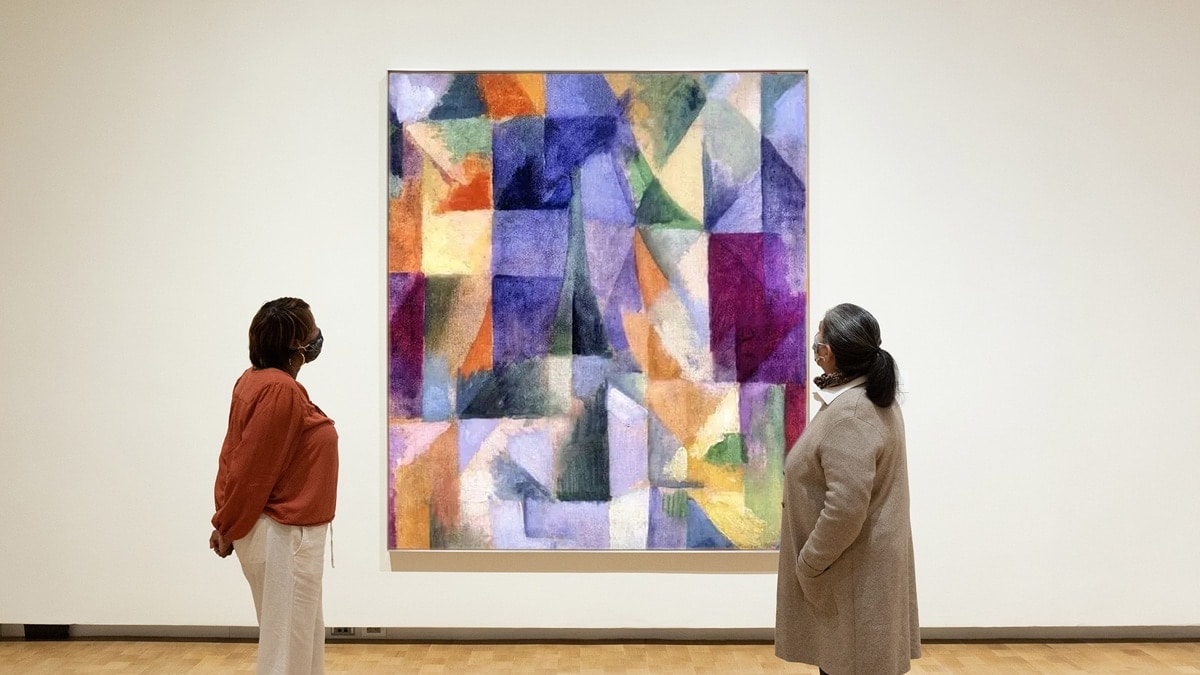
“Windows Open Simultaneously” is part of a twenty-two painting series called “Windows” by Robert Delaunay.
When asked about this painting in 1913, Delaunay wrote, “Line is the limitation; the color gives depth, not perspectival, not successive but simultaneous depth—as well as form and depth.”
The fractured pattern not only gives the abstract artwork its personality but also makes it one of the most famous cubist compositions.
It is now housed at the Philadelphia Museum of Art.
If you like this classical art, you can try to make it into corresponding artworks, such as reproduction paintings, posters, enamel pins, and so on. Personally, custom Enamel Pins can fully present various artistic patterns and they can be great on many levels.
They can not only be collected, and decorated, but they can also be given to others as gifts. You can definitely try getting one at gs-jj.
| Artist | Robert Delaunay |
| Date of Creation | 1913 |
| Dimensions | 57 cm x 123 cm |
| Location | Philadelphia Museum of Art |
2. Composition VII (1913)
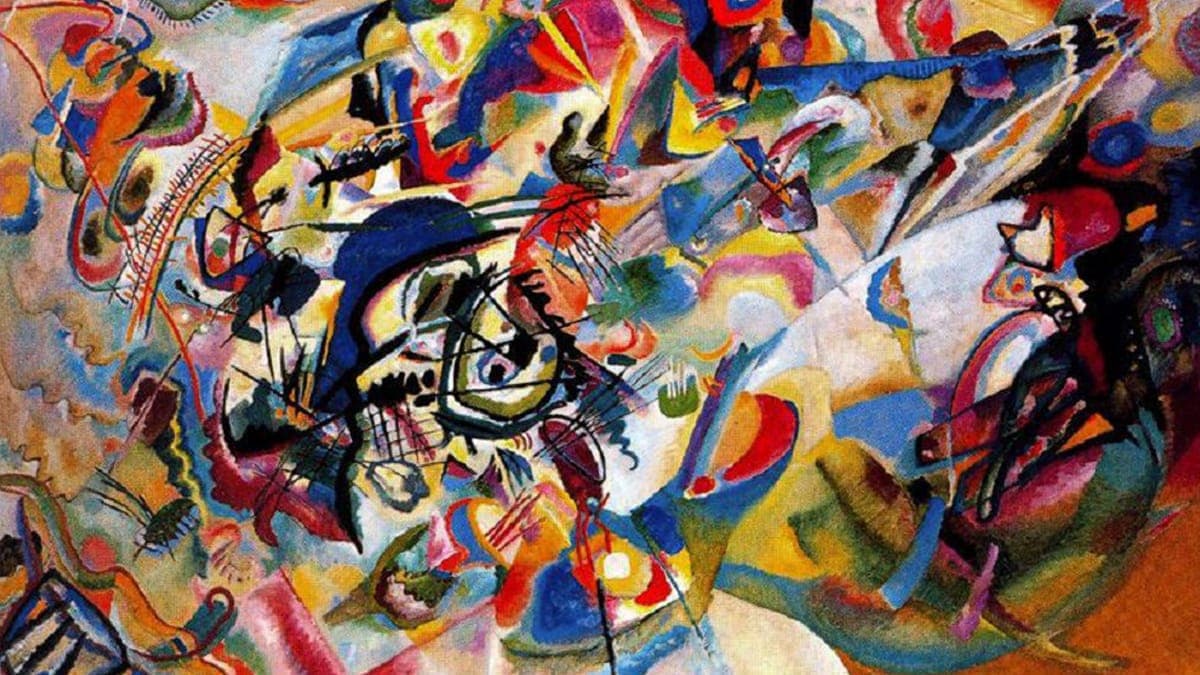
Wassily Kandinsky was a famous abstract painter, known for comparing his abstract paintings to music, which is why he called them compositions.
Emotions of anger and disgust are seldom portrayed when someone looks at this famous abstract painting for the first time.
Still, people who are willing to invest time in painting will be successful in various spiritual and intellectual experiences.
The colors in the painting give a still note to the mind and challenge the viewer to keep them interested.
A bit of harmony is injected into the viewer out of the complete disarray of colors and crisscrossing black lines.
This combination is so harmonic that the viewer is said to receive a still note from the painting.
Composition VII is indeed a very intriguing subject in itself. It would surely be a great idea to own one.
The original one would probably cost a million bucks. Looking for a cheap and convenient alternative? Check out Kandinsky Reproduction paintings by PortraitFlip.
| Artist | Wassily Kandinsky |
| Date of Creation | 1913 |
| Dimensions | 200.6 cm x 302.2 cm |
| Location | Tretyakov Gallery, Moscow |
3. Improvisation 31 (Sea Battle) (1913)
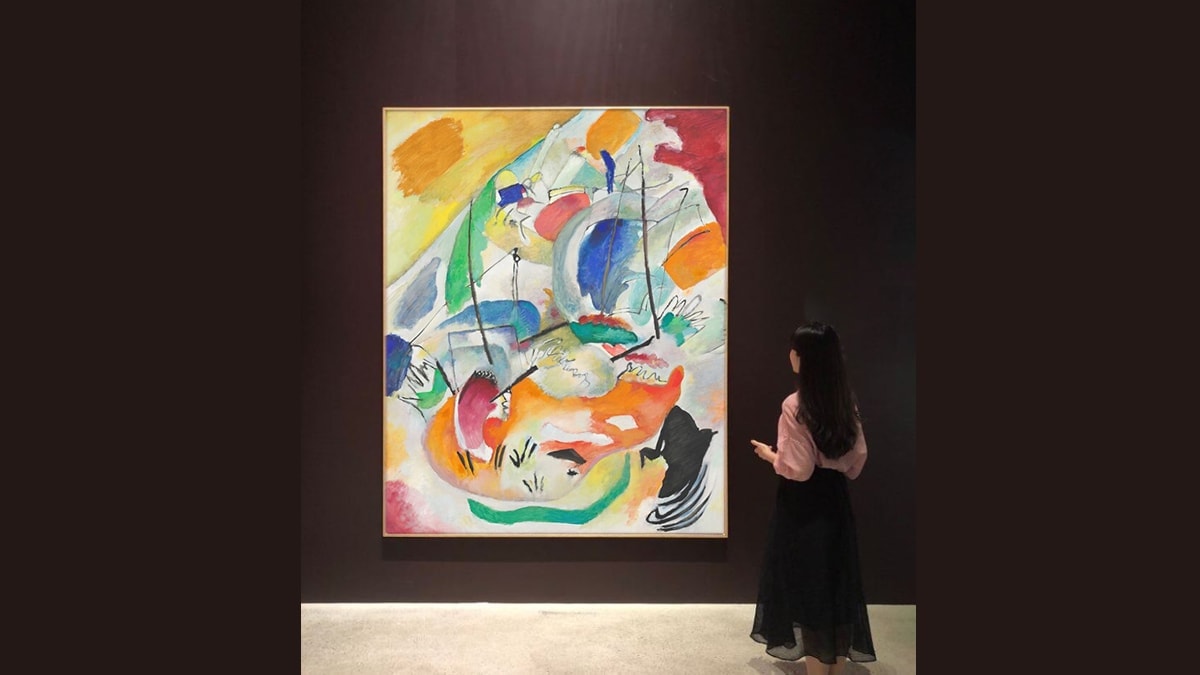
Wassily Kandinsky created this abstract masterpiece right before World War 1.
In this abstract painting, Wassily has brilliantly used the contrast of colors to show two ships locked in battle.
The artist’s hope for humanity to turn away from conflict and suffering and turn toward something wholesome is conveyed in “Improvisation 31.”
The use of the color white in the background and the clouds serves to emphasize this point.
In addition, the vivid yellow representing cannon fire and the deep blue representing waves give the abstract artwork a dreamy appearance.
It stands for both the turmoil of time and the paradise that awaits humanity if they can only put aside their differences.
Sadly, this was also his last painting from the Improvisation Series of paintings.
| Artist | Wassily Kandinsky |
| Date of Creation | 1913 |
| Dimensions | 140.7 cm x 119.7 cm |
| Location | National Gallery of Art in Washington, D.C. |
4. Electric Prisms (1914)
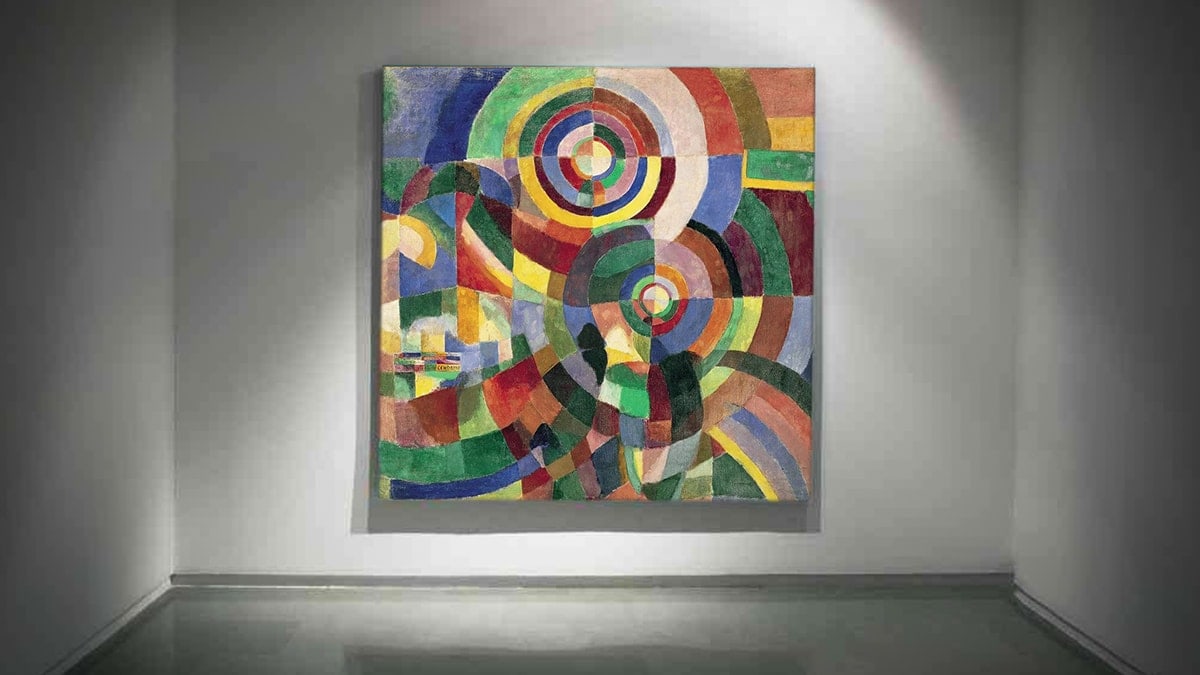
This popular abstract art was born when Sonia Delauney and her artist husband, Robert, saw a light post while they were on a walk.
They both decided to challenge themselves to capture the glow of that lamp.
That’s when Sonia gave birth to Electric Prisms.
The main elements are the two overlapping circles, which are made of various other semicircles, comprising various bands of color.
Sonia described these circles as halos of light and shadow, and the bands were to show the vibration in the light.
She was heavily influenced by the concepts of simultaneity and cubism. This meaningful abstract art was the result of it.
| Artist | Sonia Delaunay |
| Date of Creation | 1913 |
| Dimensions | 250 cm x 250 cm |
| Location | Musée National d’Art Moderne, Paris |
5. Black Square (1915)
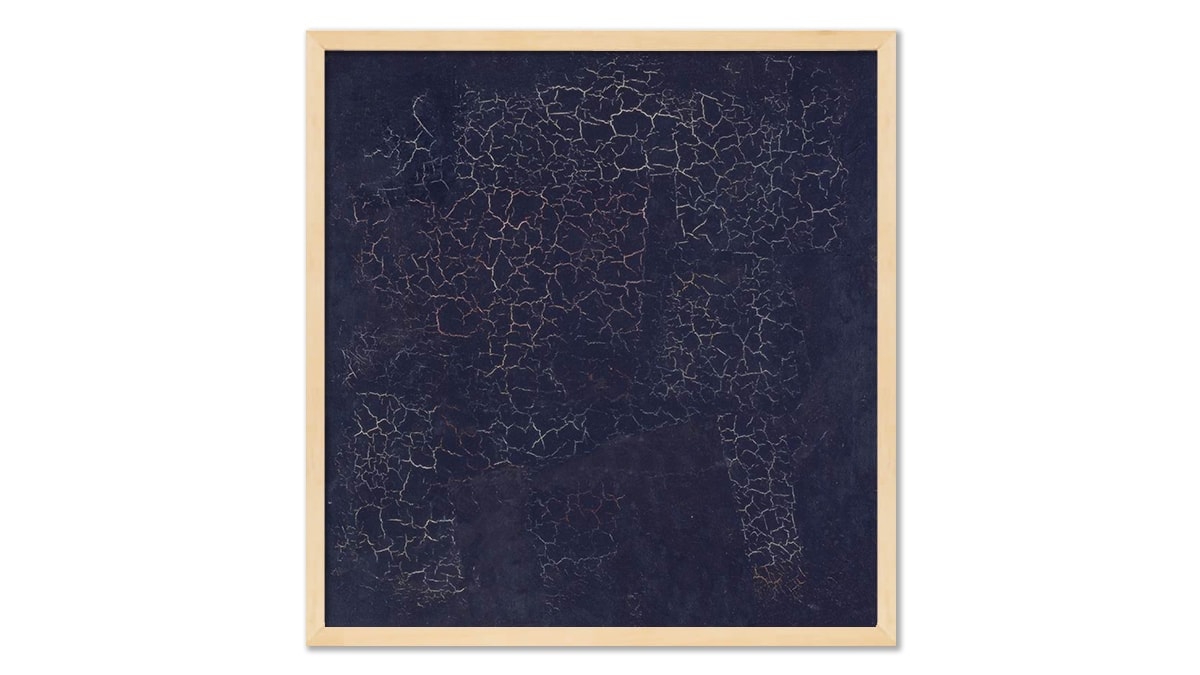
The style in which Kazmir Malevich painted this renowned abstract painting is known as “Suprematism”.
It refers to art based upon the “supremacy of the pure artistic feeling”.
Most artists regard this artwork as one of the best abstract paintings ever created.
Malevich himself described the abstract painting as not an “empty square” but a “feeling of non-objectivity”.
Its simplicity and ability to captivate the viewer’s attention for hours on end, perhaps make it a widely known abstract art.
An interesting fact about this painting is that if you X-ray it, you can read, “A Battle of the Negroes…”.
| Artist | Kazimir Malevich |
| Date of Creation | 1915 |
| Dimensions | 79.4 cm x 79.4 cm |
| Location | The State Tretyakov Gallery, Moscow |
6. The Swan, No. 17( 1915)
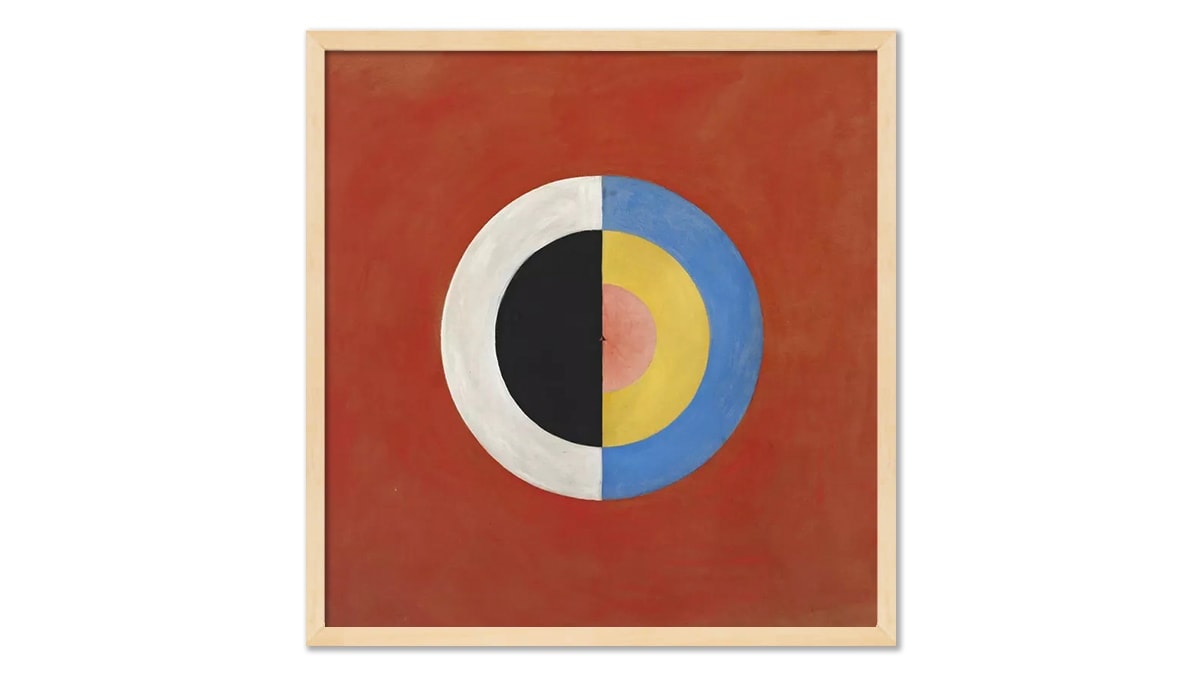
Swan No. 17 is arguably the most minimalist work created by abstract painter Hilma Af Klint.
The artwork itself is considerably large, with a height of 1.5 meters.
The dark red background of the painting represents fire, and the sphere in the “sea of fire” represents the swans.
On the left, the black and white half is the female swan, and on the right side, the red, yellow, and blue half is the male swan.
Swans stay together for a lifetime and raise their young ones. Two halves of spheres coming together represent the interaction between them.
It may have been the best of the best abstract art pieces but it got its due attention and love very late, as the artist wanted most of her work to be private until her death.
| Artist | Hilma af Klint |
| Date of Creation | 1914-1915 |
| Dimensions | 150.5 cm x 151 cm |
| Location | Moderna Museet in Stockholm, Sweden |
7. Suprematist Composition (1916)
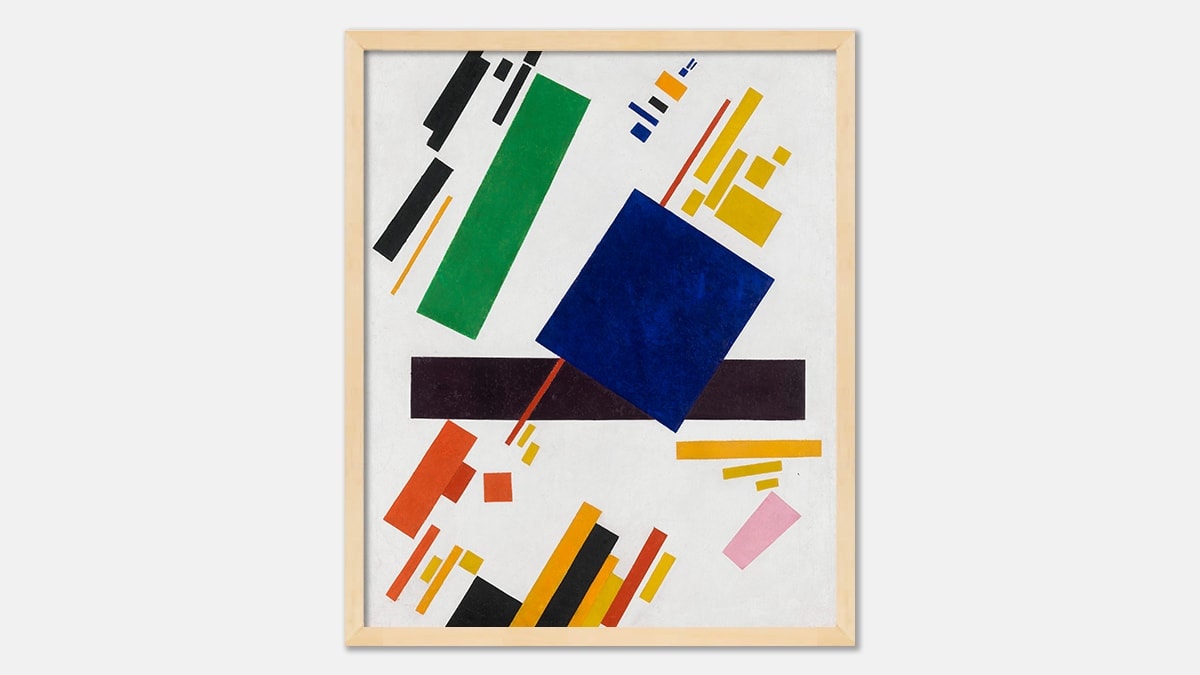
Suprematist Composition, widely regarded as Kazimir Malevich’s finest creation, is praised for being a technical achievement due to its sparse use of color.
However, the abstract painting still seems bright and draws the viewer’s attention at first glance.
In order to depict the power struggle that existed during World War I, the artist used both black and colored blocks.
The painting’s language was intended to deviate from the established conventions of art by illustrating paint, surface, geometric shapes, and their primary colors.
Later, this art had to go through a ban as the Soviet Union believed that it was a symbol of insubordination and free will.
| Artist | Kazimir Malevich |
| Date of Creation | 1916 |
| Dimensions | 88.5 cm × 71 cm |
| Location | Private collection |
8. White on White (1918)
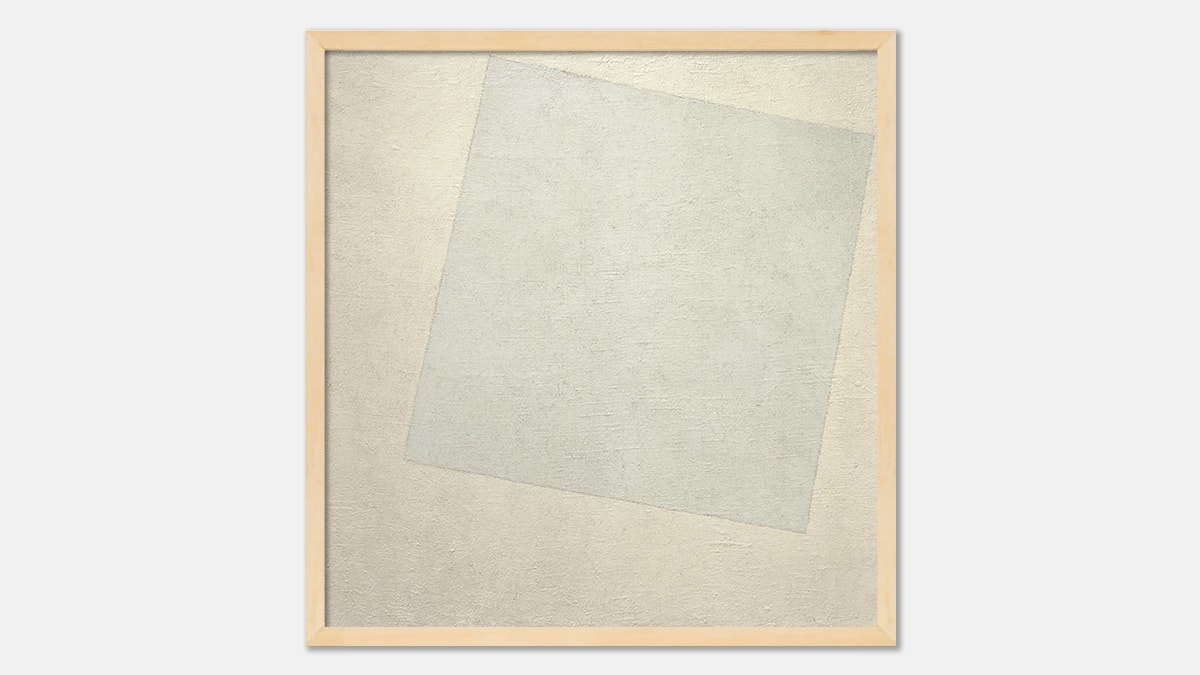
This abstract painting, which he finished shortly after the previous one, served to further support his suprematism.
Malevich was fascinated by technology, particularly with airplanes. He even studied the subject that dealt with aerial photography.
While working on White on White he envisioned a sense of floating and transcendence in it. Which is why he used the white color on purpose to feed his belief system that white is the most dominant and infinite color.
To his mind, a white color would signify a realm of higher feeling.
The most famous abstract painting found its home in the Museum of Modern Art, New York, in 1963.
| Artist | Kazimir Malevich |
| Date of Creation | 1918 |
| Dimensions | 79 cm x 79 cm |
| Location | Museum of Modern Art, New York City |
9. Tableau I (1921)
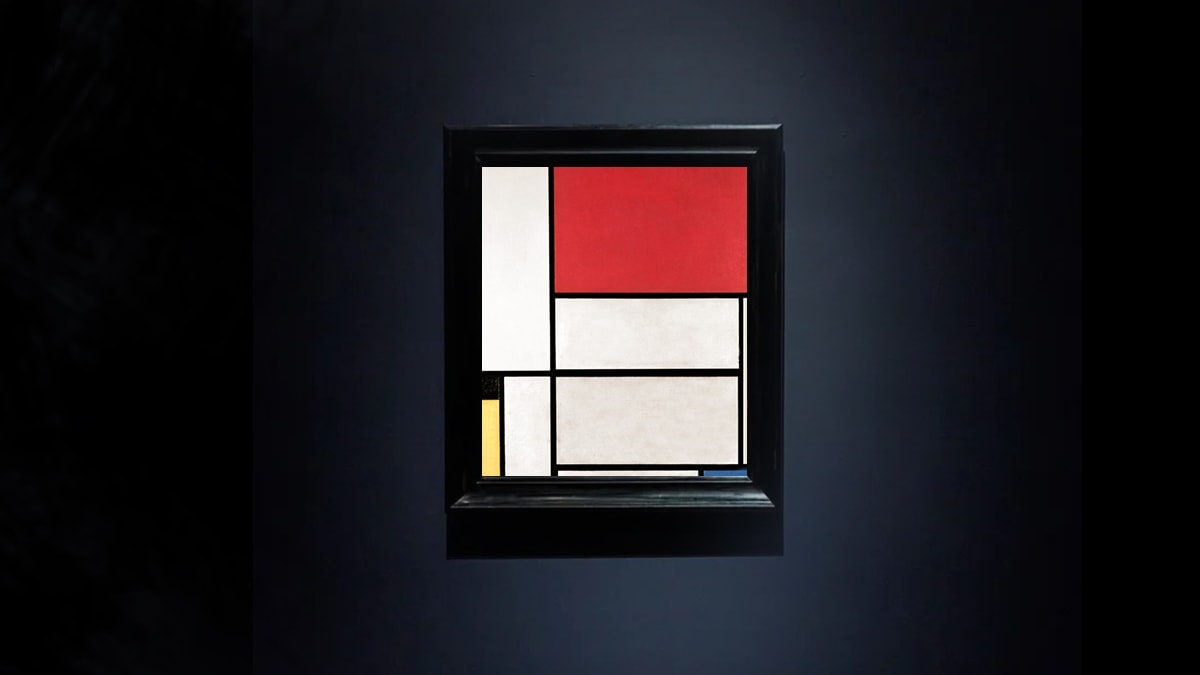
Painted by Piet Mondrian in 1921, this famous abstract painting is said to follow his ideals of grid painting.
The artwork also displays the rejection of imitation, which Piet considered a reprehensible representation of reality.
Before getting his hands on the art, he served as a member of the Dutch De Stijl movement in 1917.
The ideals of that movement were white backgrounds and black bars, creating a division in the frame, which is distinct in this artwork.
Later, Piet clarified that he was inspired by the great Pablo Picasso and Georges Braque while making this artwork.
That not only makes it a famous abstract painting but also makes Piet Mondrian one of the most iconic artists of cubism.
| Artist | Piet Mondrian |
| Date of Creation | 1921 |
| Dimensions | 103 cm x 100cm |
| Location | Museum Ludwig in Cologne, Germany |
10. Blue and Green Music (1921)
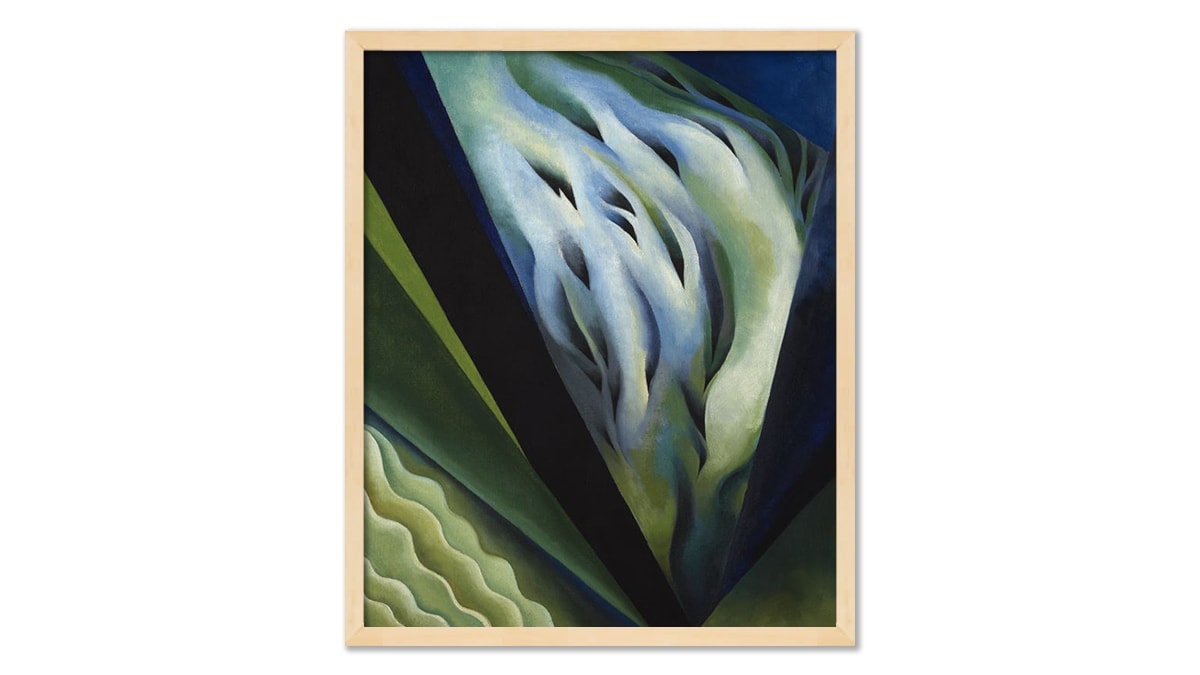
Georgia O’Keeffe’s main motto for her abstract art was to create visual images of the sounds she heard.
The idea that music can be visualized through images and colors fits with Georgia’s commitment to American modernism.
She used subdued color tones to give the waves in her composition, Blue and Green Music, the appearance of music.
Light colors are said to have a high pitched sound, whereas darker colors are said to have a deep and menacing sound.
Apart from the audible clues, this famous abstract painting itself is the image of flower petals dancing in the wind, but because of its shape, it also appears to be female genitalia, which was another common motif the artist employed.
| Artist | Georgia O’Keeffe |
| Date of Creation | 1921 |
| Dimensions | 58.4 cm × 48.3 cm |
| Location | Art Institute of Chicago |
11. Senecio (1922)
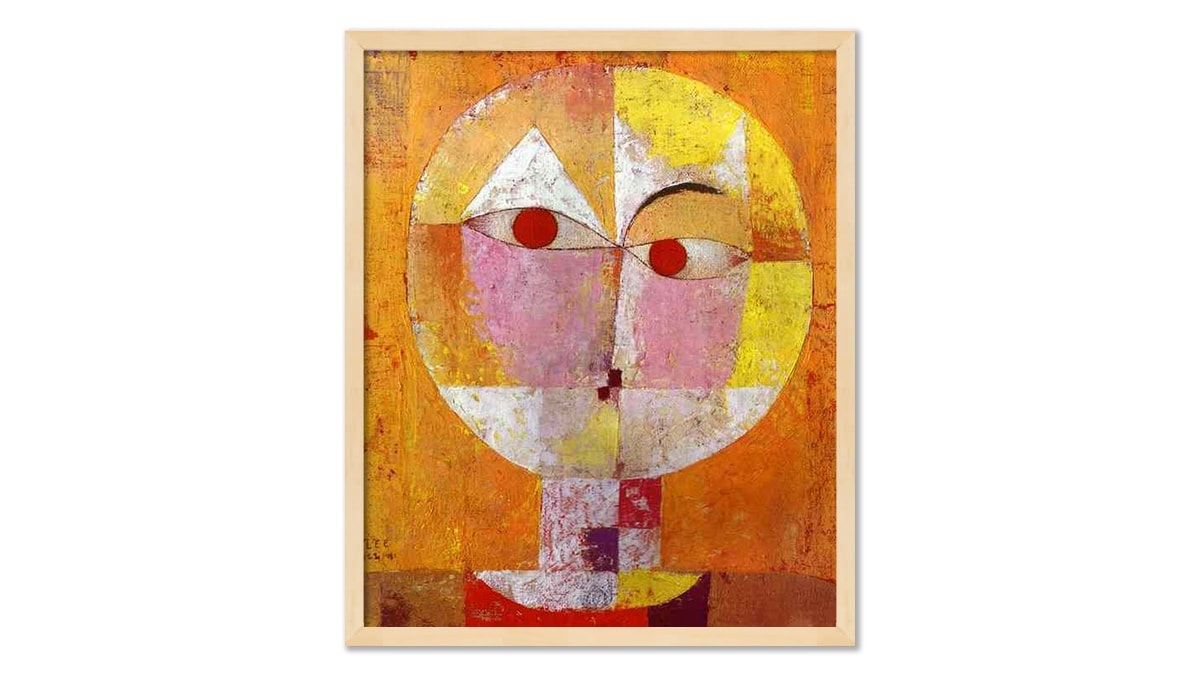
Paul Klee created this most famous artwork, Senecio.
He had a distinct style of abstraction in his mind; he made it look as if his artworks were made by children.
The abstract art shows various geometric structures to produce facial characteristics for the subject.
He was inspired by the artistic cultures of Africa, which drove him to use various shades of red and yellow to make the man in the picture appear senile.
The portrayal of the subject makes it one of the most famous abstract art faces in the world.
| Artist | Paul Klee |
| Date of Creation | 1922 |
| Dimensions | 40 cm x 38 cm |
| Location | Kunstmuseum Basel, Basel |
12. Twittering Machine (1922)
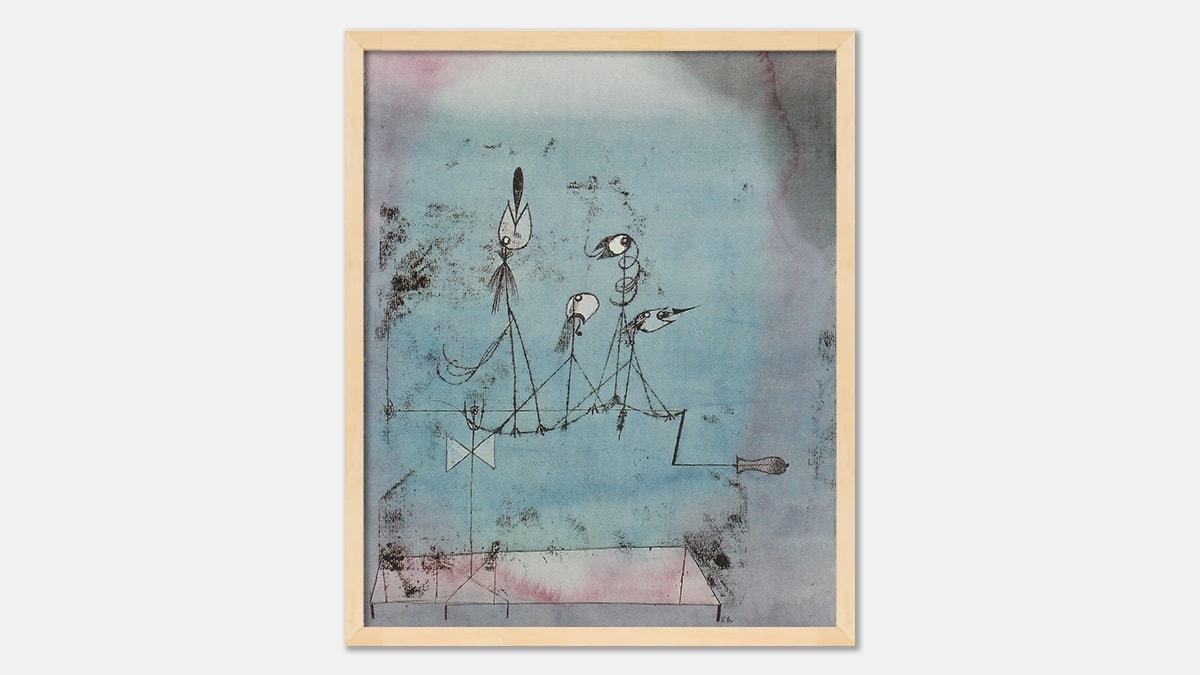
As the name suggests, artist Paul Klee’s main message from this classic abstract painting is to focus on the sound of birds.
It consists of a hand-cranked machine that is supposed to power four birds sitting on a line.
Klee himself explained the painting as, “an active line on a walk, moving freely.”
The smudges on the paintings aren’t intentional but actually an accident caused by the artist himself, who was trying to copy the paintings onto another canvas.
During Nazi rule, Klee and his artwork were deemed “degenerates” and were removed from exhibitions.
Thankfully, this great abstract painting was exported to the United States before it could be destroyed.
| Artist | Paul Klee |
| Date of Creation | 1922 |
| Dimensions | 63.8 cm × 48.1 cm |
| Location | Museum of Modern Art, New York |
13. La Mancha Roja (1925)
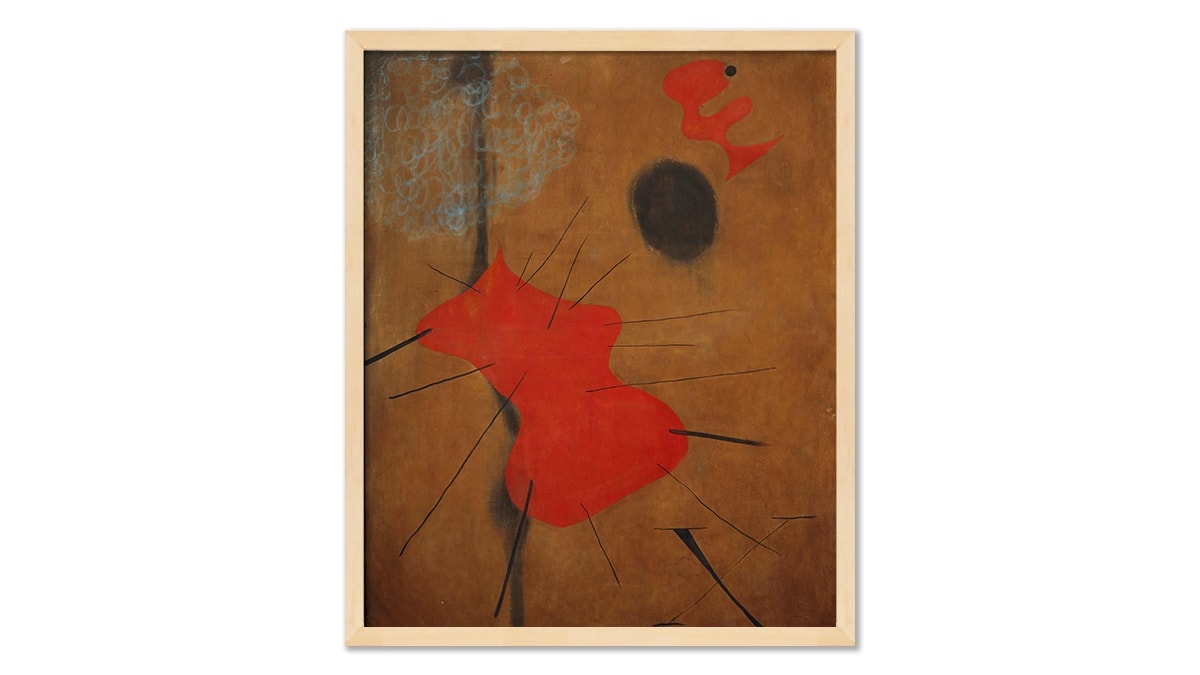
La Mancha Roja, or “the red spot,” was painted by Joan Miro.
Never considered an abstract painter, his artworks convey the message of abstraction and surrealism.
Many artists consider it disturbing, as it tries to depict Joan’s mind and represents his subconscious.
According to legend, the red spot in the center of the canvas represents the artist himself, and all the black lines represent the difficulties he was facing at the time.
This painting is also a trendsetter, as it paved the way for the dreams and visions of artists to be portrayed on canvas.
It’s a rare, abstract, and highly complicated abstract art that opens many stories if you study its elements closely.
| Artist | Joan Miro |
| Date of Creation | 1925 |
| Dimensions | 146 x 114 cm |
| Location | Room 206.02 – Documents Magazine |
(Also Read: Abstraction of Art)
14. Composition II (1930)
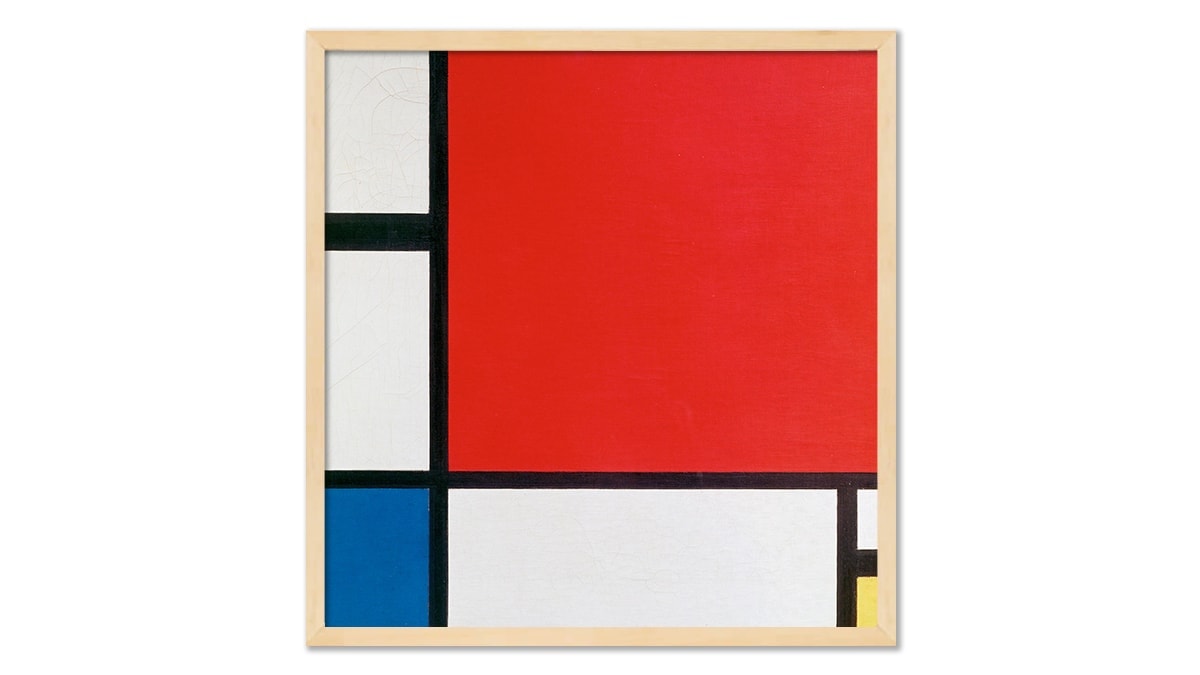
Piet Mondrian’s Composition II represents more than just some colors on a canvas; it is actually symbolic of deep-held philosophies around the world.
He thought that everything in the universe was in some way interconnected and harmonious.
And he tried to convey it through this famous abstract painting by using black bars and primary colors to signify balance and add depth to it.
The artist has subtly added brushstrokes that are rarely visible, adding life to the painting.
Composition II with Red, Blue, and Yellow is the epitome of the neoplasticism movement.
The movement of which Piet Mondrian himself was a big part.
| Artist | Piet Mondrian |
| Date of Creation | 1930 |
| Dimensions | 45 cm × 45 cm |
| Location | Kunsthaus, Zurich |
15. 1934 relief (1934)
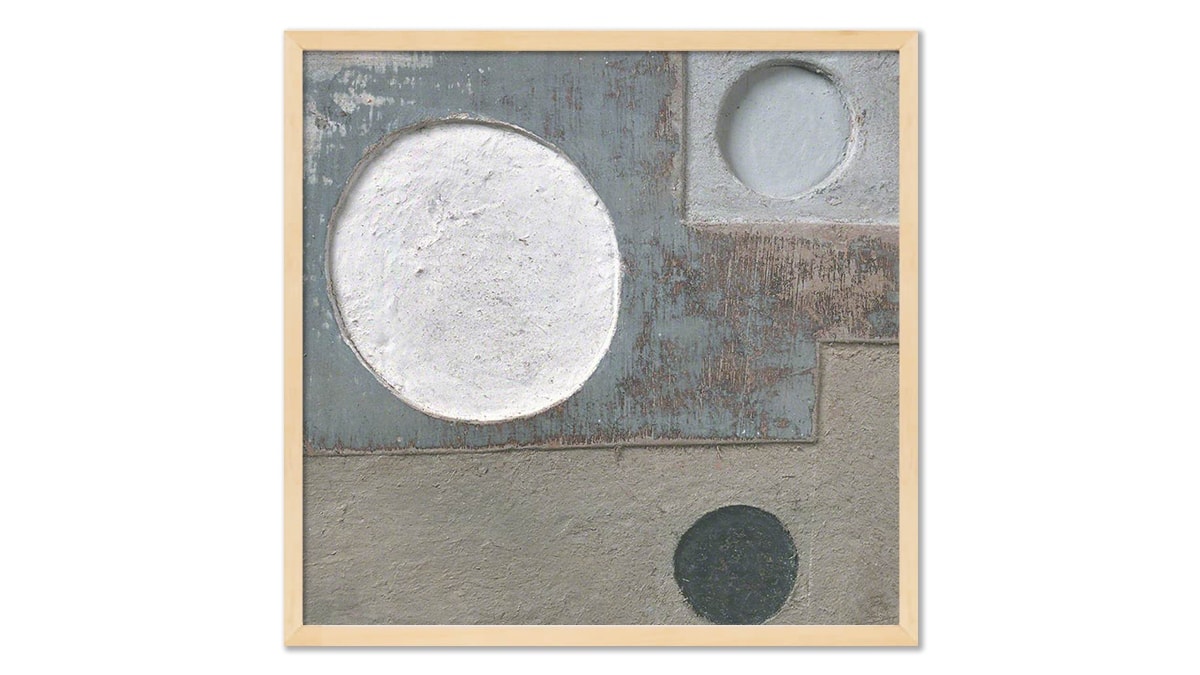
Ben Nicholson’s primary goal was to portray space in a painting that demonstrates his avant-garde painting techniques.
Initially, the painting was just an irregular white on white painting.
Later in the year, Ben cut out the circles and the rectangles, which gave the artwork a collage-like feel.
The main motto of the painting was to signify the balance and depth that can be achieved in a painting.
Ben later inducted this abstract artwork into the Kettle’s Yard collection.
It was the only one that was made before World War II in the collection.
Now it is among the collections of Tate St. Ives.
| Artist | Ben Nicholson |
| Date of Creation | 1934 |
| Dimensions | 718 x 965 x 32 mm |
| Location | Tate St. Ives |
16. Death and Fire (1940)
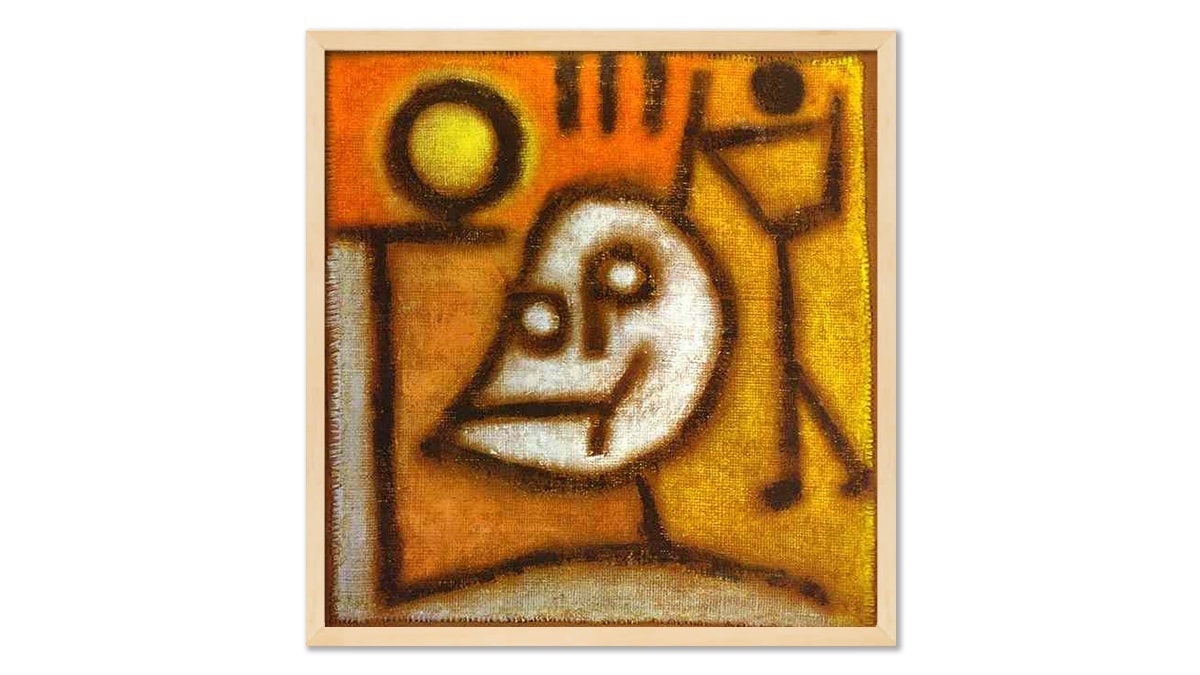
The fact that Paul knew he was going to die soon and painted a death scene in the picture makes it one of the most disturbing abstract paintings.
The main subject of the painting, “Tod,” means death in German and was often compared to the artist himself.
It’s said that Death himself is the figure running in the back right corner toward Tod.
A yellow glow covers the abstract artwork, which depicts the sunset and the end of life.
The final image of this abstract painting is a symbol of a funeral, where the ferryman takes you to the afterlife.
| Artist | Paul Klee |
| Date of Creation | 1940 |
| Dimensions | 43 cm × 43 cm |
| Location | Zentrum Paul Klee, Bern, Switzerland |
17. Broadway Boogie Woogie (1943)
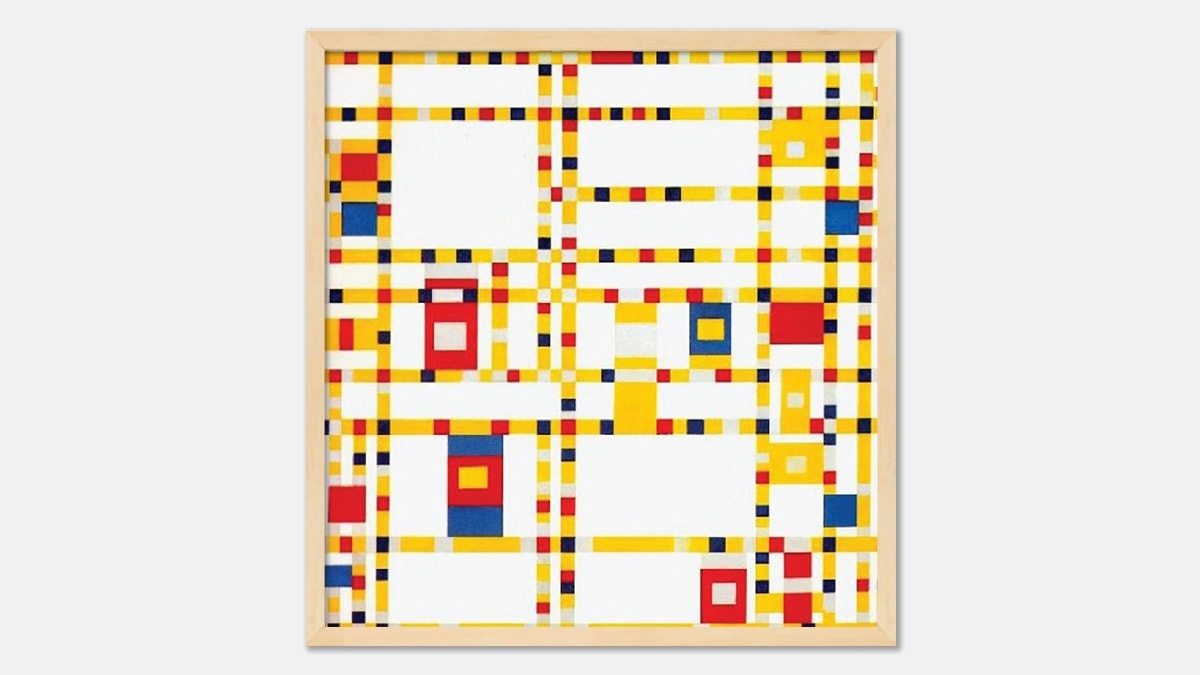
Broadway Boogie Woogie, created in 1944, was the last painting painted by Piet Mondrian.
The initial painting started with yellow lines running through a white background, with various color patches connecting them.
Later, small blocks of red, green, and gray were added to give the painting a new personality.
This is unlike his other works, which have huge spaces of white in between the black bars.
This was because of the change in music that Piet had started to listen to, which portrayed a different era in his life, his last phase, to be precise.
The owner of the painting, Martins, later donated the painting to the Museum of Modern Art, where it still rests.
| Artist | Piet Mondrian |
| Date of Creation | 1943 |
| Dimensions | 127 cm x 127 cm |
| Location | The Museum of Modern Art |
18. Full Fathom Five (1947)
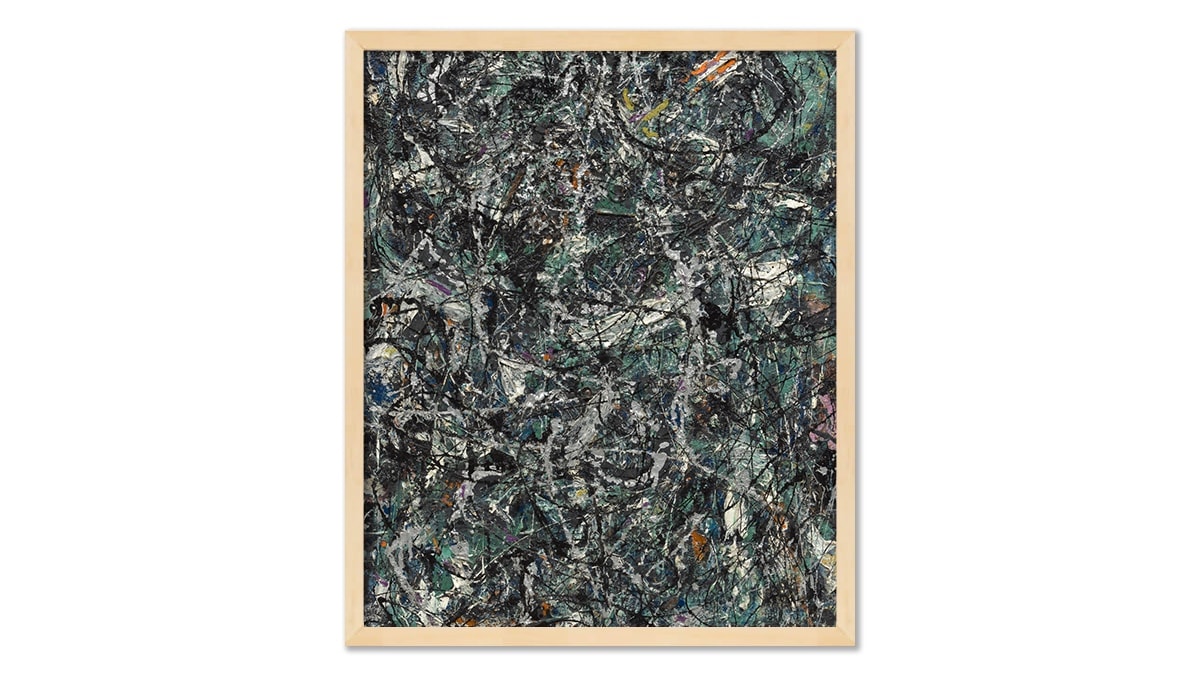
Full Fathom Five by Jackson Pollock is the most iconic abstract painting in its brief history.
With principles of surrealism and abstraction, this abstract artwork might seem like “too much” to an average art viewer.
But it displays the seas and their dangers through the genius use of green, blue, and black colors.
The depth portrayed by Jackson’s techniques gives the viewer an insight into his style of painting and mindset.
This painting received significant attention from the artist community, making it one of the most famous abstract paintings ever painted.
| Artist | Jackson Pollock |
| Date of Creation | 1947 |
| Dimensions | 77 cm × 129 cm |
| Location | Museum of Modern Art in New York City |
19. White Center (Yellow, Pink, and Lavender on Rose.) (1950)
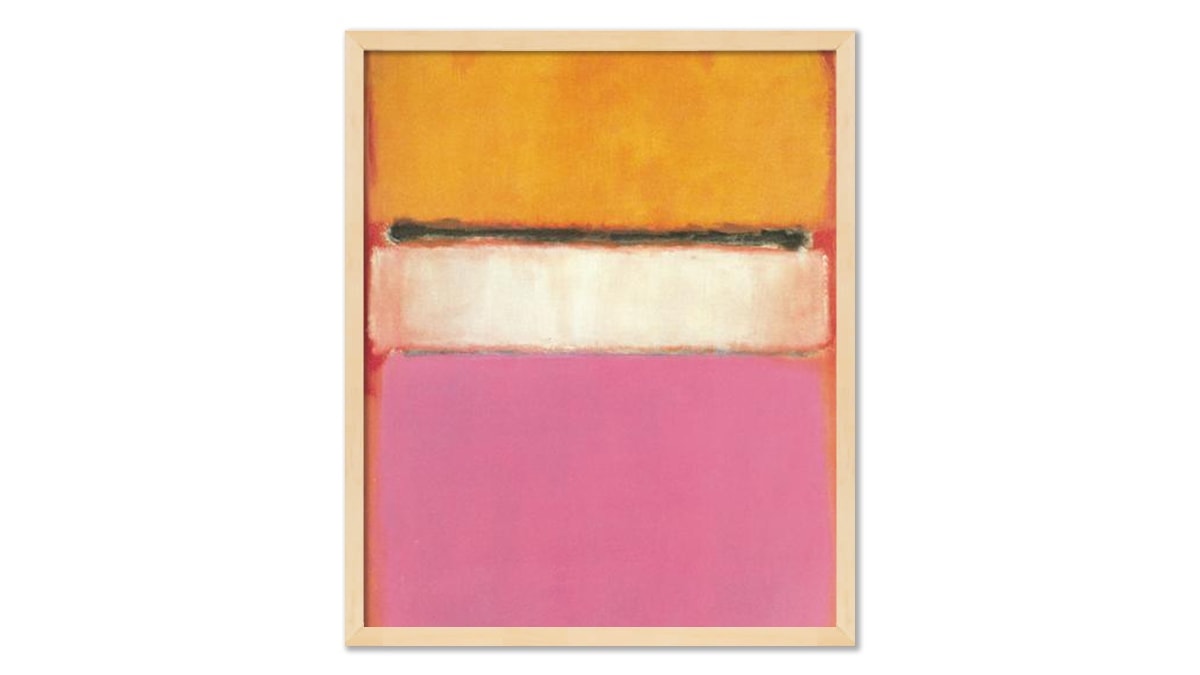
White Center painting is by one of the most famous abstract artists, Mark Rothko.
It is based on his signature painting style, called the Multiform Style.
In this style, multiple blocks of vivid colors are stacked upon each other on a canvas.
From top to bottom, the colors are red, yellow, black, white, and lavender.
Every color other than white resembles the elements of the Earth, whereas white resembles the Sun.
In 2007, this painting was sold to the Royal Family of the UAE for $72.85 million. It’s huge!
| Artist | Mark Rothko |
| Date of Creation | 1950 |
| Dimensions | 206 cm x 141 cm |
| Location | Private collection |
20. Autumn Rhythm Number 30. (1950)
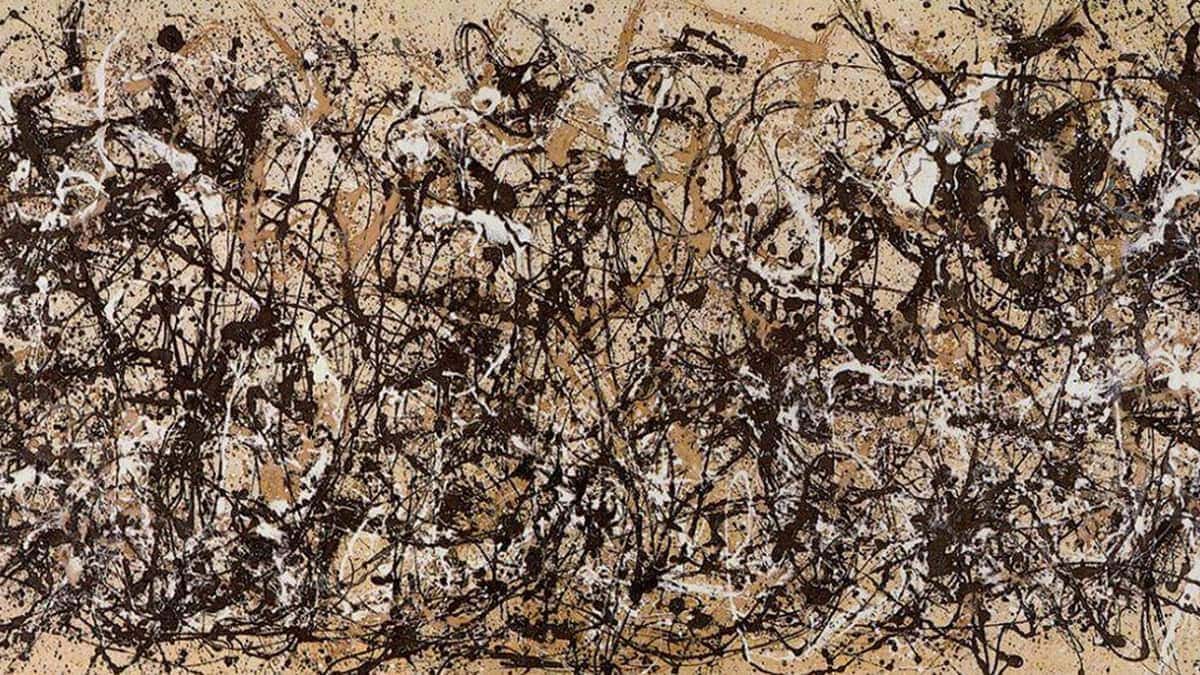
Another painting by Jackson Pollock, Autumn Rhythm Number 30, shows the characteristics of his signature style called “Drip Painting.”
While painting this painting, Jackson laid the canvas on the ground instead of placing it on a stand.
He used sticks, knives, and thinned paint to achieve an unorthodox outcome, which would be unique to his painting.
Autumn Rhythm’s main message was to deliver the philosophy and teachings of surrealism.
The colors of black dripped on a canvas that has a yellow hue help in bringing out the autumn feel, justifying its name.
| Artist | Jackson Pollock |
| Date of Creation | 1950 |
| Dimensions | 266.7 cm × 525.8 cm |
| Location | The Metropolitan Museum of Art |
21. One Number 31 (1950)
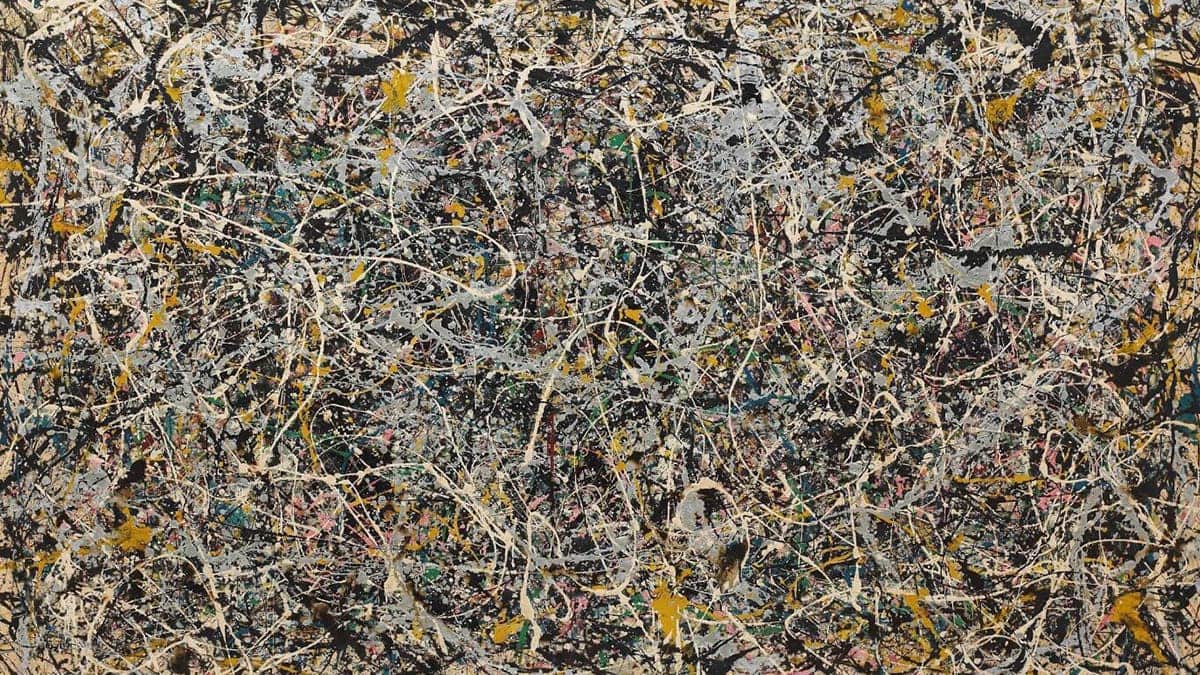
One of Jackson Pollock’s largest paintings, which is also similar to his previous abstract painting “Autumn Rhythm”.
Jackson also employs the same methods as in that painting, laying the canvas flat on the ground and drizzling paint all over it.
The painting itself is a compilation of the colors tan, blue, and gray splattered all across the canvas.
When asked about this technique, Pollock said, “I am more at ease. I feel nearer, more a part of the painting since this way I can walk around it, work from the four sides, and be in the painting. “
Critics said that the way he moved while creating the famous painting looked like he was dancing.
Because of these methods, One Number 31 feels more energetic and awe-inspiring to look at.
| Artist | Jackson Pollock |
| Date of Creation | 1950 |
| Dimensions | 270 cm x 531 cm |
| Location | The Museum of Modern Art |
22. Red (1952)
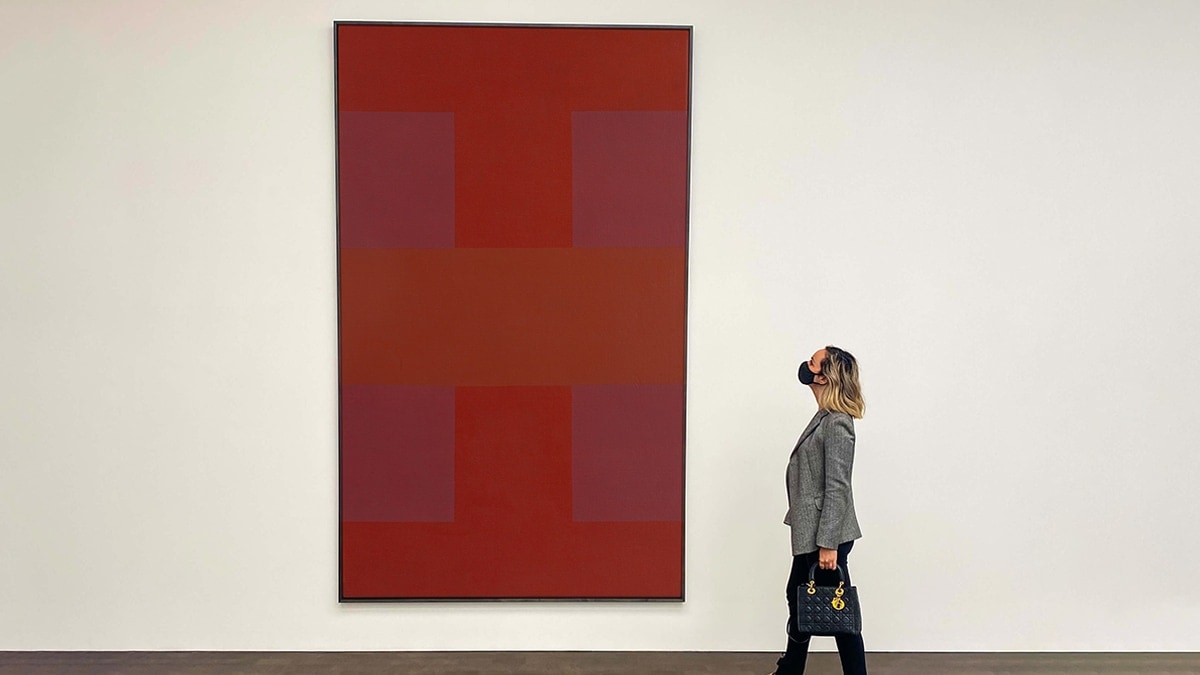
Ab Reinhardt’s works are almost always composed of grids that possess only a single tone.
One of his best-known abstract pieces is Red, made with brushwork so delicate as to hardly be seen on the canvas.
The two inverted red colored T’s are surrounded by squares with the warmer tone of the color red.
This creates a focus on the vibrant red in the middle, giving depth to the painting.
Overall, the famous abstract painting is said to be about shape, color, and symmetry all over the canvas.
| Artist | Ab Reinhardt |
| Date of Creation | 1952 |
| Dimensions | 274.4 x 102 cm |
| Location | The Museum of Modern Art |
23. Mountains and Sea (1952)
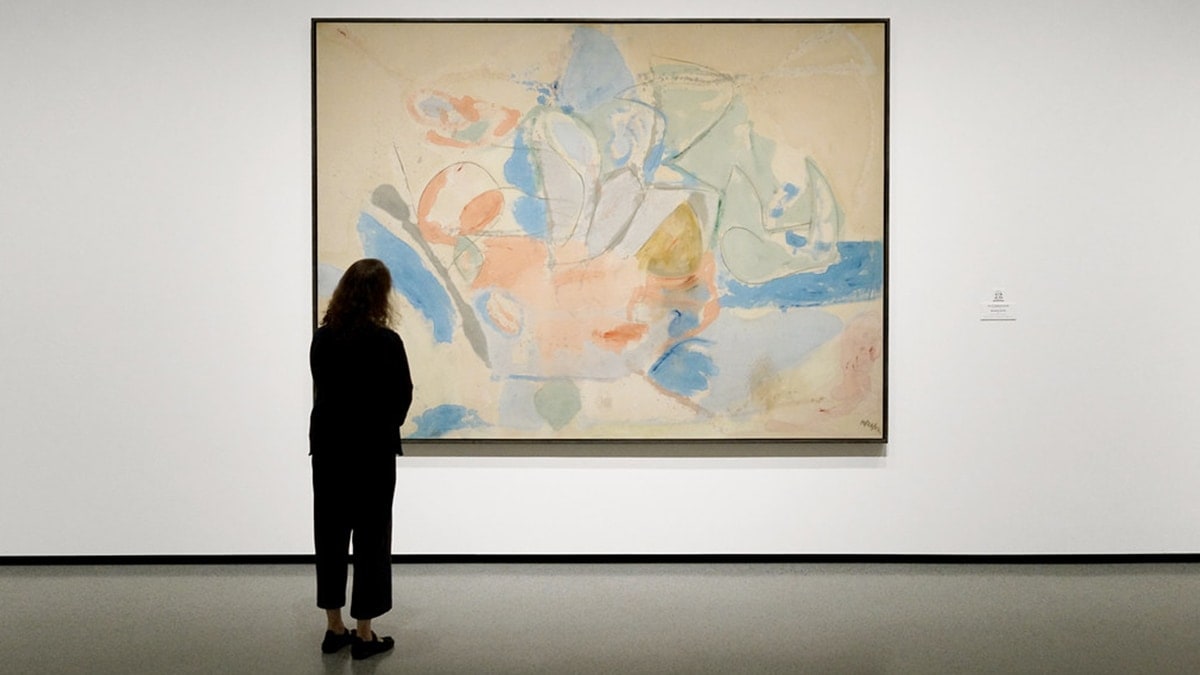
Helen Frankenthaler created it when she was just 23 years old.
She used a method called staining, which involved painting with thin paint onto a raw canvas.
Mountains and Sea (1952) consists of intricate and well-planned brush strokes to differentiate it from landscape painting.
Helen used dark black strokes to give character to her artwork after the final painting.
It is also considered an abstract landscape painting because of the incorporation of various art elements.
When released, the critics hated the painting, but later it became her most coveted painting.
| Artist | Helen Frankenthaler |
| Date of Creation | 1952 |
| Dimensions | 220 cm × 297.8 cm |
| Location | National Gallery of Art, Washington, D.C |
24. Convergence (1952)
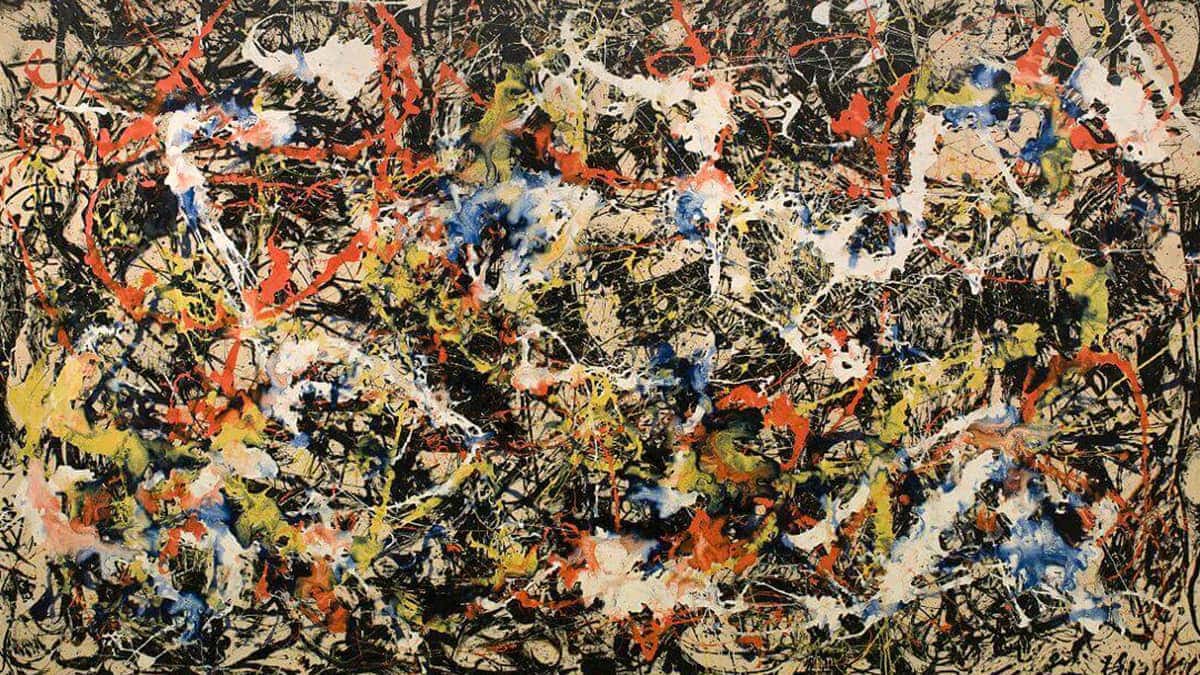
Convergence is probably Jackson Pollock’s most famous abstract artwork.
The painting was said to be the embodiment of free speech and freedom of expression.
There are circles, swirls, lines, and splatters of color all across his canvas, representing the artist’s rebellious nature.
Because of this, it is also considered the pinnacle of abstract expressionism.
On the canvas, paint has been brushed and dripped in various patterns to create the artwork.
These patterns intrigue the viewer because of the contrast of lighter and darker hues.
The replica was later divided into pieces and made into a puzzle that was later referred to as “the world’s most difficult puzzle.”
| Artist | Jackson Pollock |
| Date of Creation | 1952 |
| Dimensions | 237 cm × 390 cm |
| Location | Buffalo AKG Art Museum |
25. Woman III (1953)
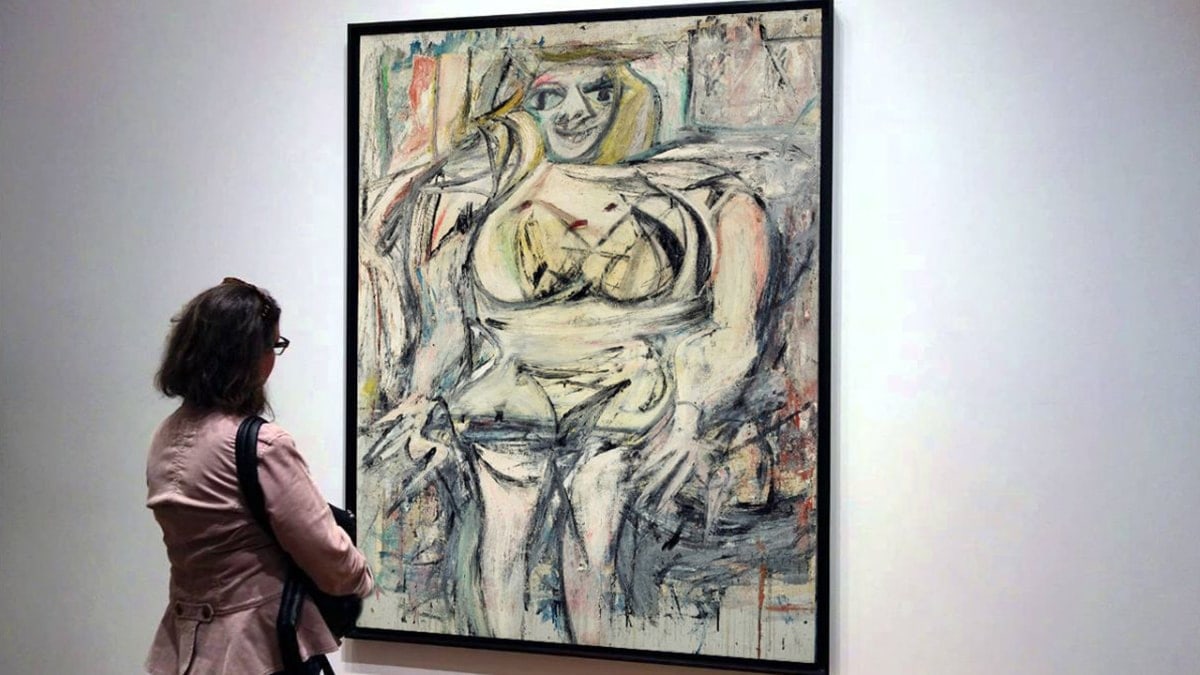
Woman III was originally a part of a six painting series called “The Woman” by Willem De Kooning.
One of the most famous abstract woman paintings, it initially received a mixed response from the public due to the aggressiveness with which the artist portrayed the nudity of the subject.
Because of this aggressive painting, De Kooning left holes in the canvas, which were later discovered.
The background and surroundings’ colors were expertly chosen by the artist to draw attention to the subject’s face in the painting.
| Artist | Willem de Kooning |
| Date of Creation | 1953 |
| Dimensions | 170 cm x 120 cm |
| Location | Private collection of Steven A. Cohen |
26. No. 61 Rust and Blue (1953)
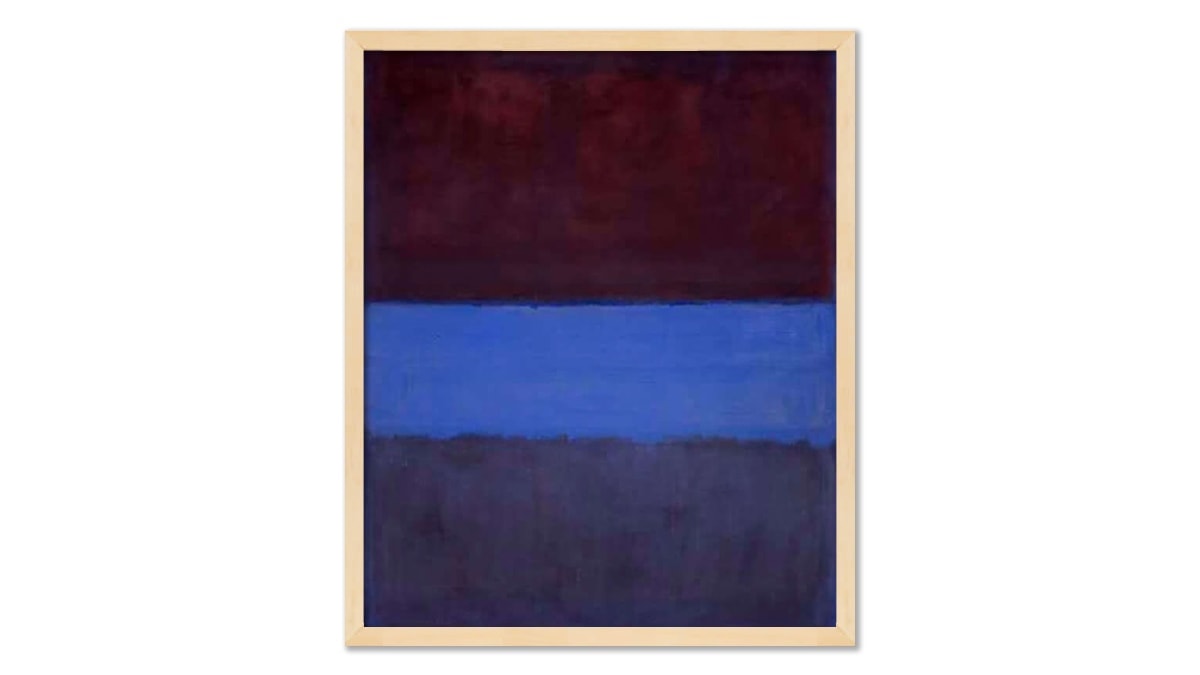
Mark Rothko traditionally painted this famous abstract artwork as per his signature style of “Multiform painting.”
This painting style features the stacking of colors on top of one another to achieve the glow that is observed in the painting.
The artists used the term “ inner light” while explaining the famous abstract artwork.
It has been featured in exhibitions across the world, including in Rome, London, Zurich, and Los Angeles.
Abstract Art Fun Fact: Rothko painted his artworks in different orientations every time and sometimes changed them at the last stage.
| Artist | Mark Rothko |
| Date of Creation | 1953 |
| Dimensions | 292.74 cm × 233.68 cm |
| Location | Museum of Contemporary Art, Los Angeles |
Suggested read: Rothko’s Entrance to Subway painting
27. Interchange (1955)
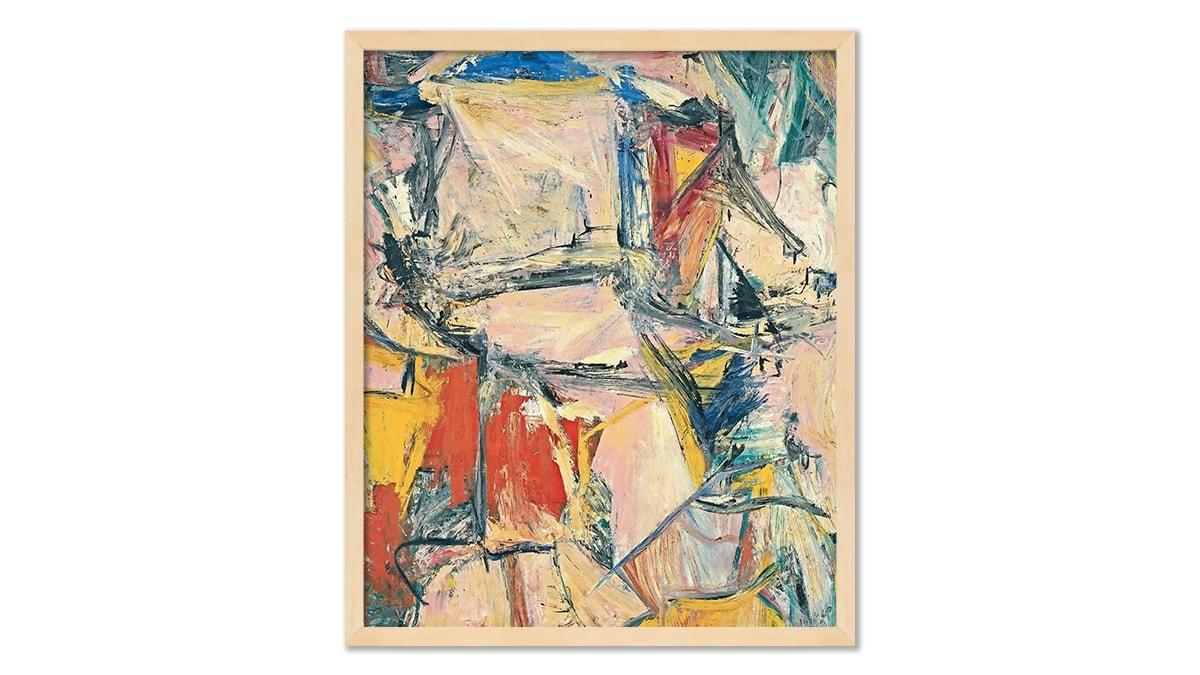
Willem De Kooning’s pièce de résistance, Interchange, was one of his most renowned works for its price.
It is the second most expensive painting in the world, with a price tag of $300 million.
Interchange features a woman sitting on a chair and is among his series of paintings called “Woman.”.
The artist used gestural strokes to create the features of this woman.
The colors that Willem used to demonstrate his interpretation of abstraction are flawless and sought out by viewers all over the world.
It is now in the private collection of Kenneth C. Griffin.
| Artist | Willem de Kooning |
| Date of Creation | 1955 |
| Dimensions | 200.7 cm × 175.3 cm |
| Location | Private collection of Kenneth C. Griffin |
28. False Start (1959)
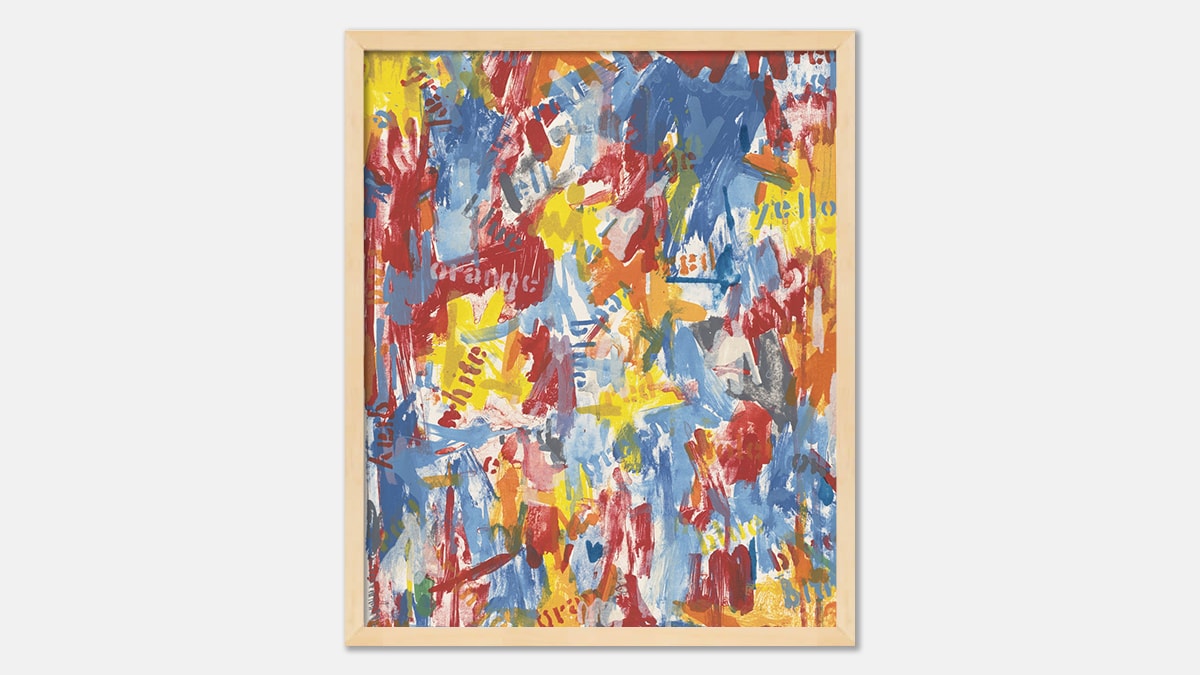
False Start by Jasper John bridges the gap between abstract art and pop art.
Because of this unique characteristic, it is also known as one of the most famous pop art paintings of all time.
Apart from the pop feature, False Start is said to have overwhelmed the viewer with its dominant brushstrokes and vivid color schemes.
The viewers would also find their eyes traveling all over the canvas because of the flags and carefully placed names on the colors.
When asked about the vague nature of this famous abstract artwork, John says, “certain limitations in my work and I had the need to overcome those…. The flags and targets have their colors positioned in a predetermined way. I wanted to find a way to apply color so that the color would be determined by some other method. “
| Artist | Jasper Johns |
| Date of Creation | 1959 |
| Dimensions | 171 cm x 131 cm |
| Location | The Museum of Modern Art in New York |
29. Orange, Red, Yellow (1961)
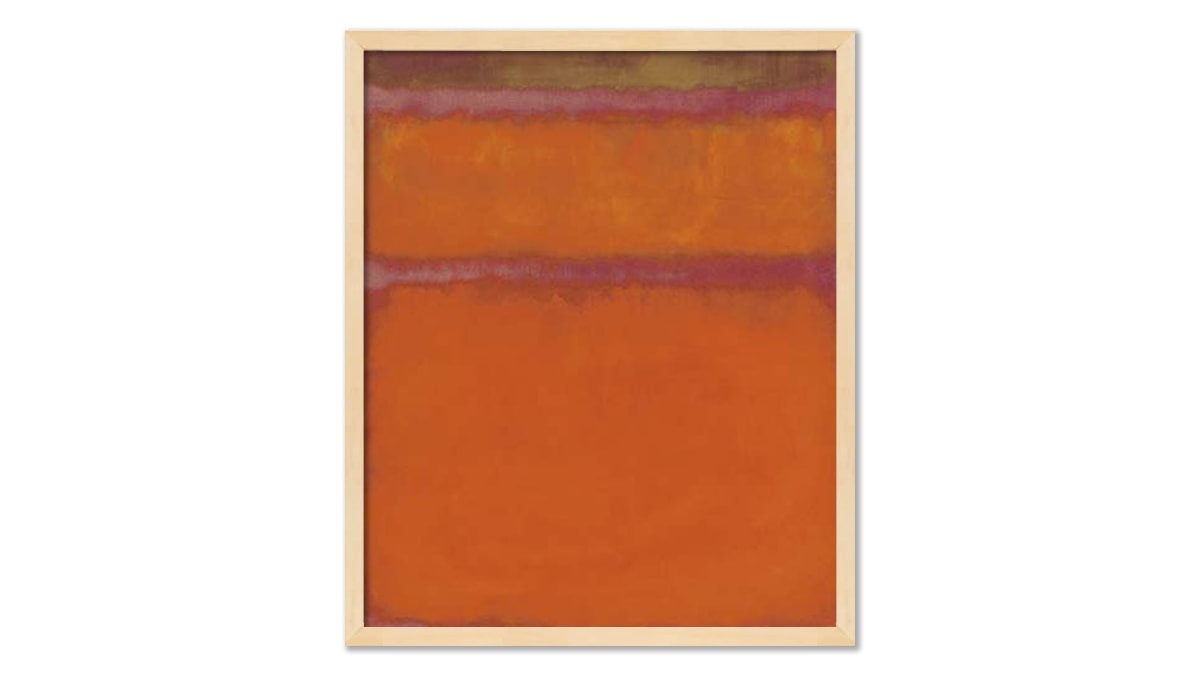
Mark Rotho’s painting Orange, Red, Yellow is one of the most famous abstract art examples of all time.
His fascination with the color red is seen all throughout this painting.
Because of the contrast between the red at the borders and the orange rectangles in the center, it gives the viewer an elevated experience.
After gazing at this painting for a long time, it is said to clean your peripheral vision.
Mark’s main objective was not to elevate the viewer but to give a strong spiritual message, which was always his niche’.
As with all of Rothko’s paintings, this was sold for $87 million in 2012.
| Artist | Mark Rothko |
| Date of Creation | 1961 |
| Dimensions | 236.2 cm × 206.4 cm |
| Location | Private collection |
30. Leda and the Swan (1962)
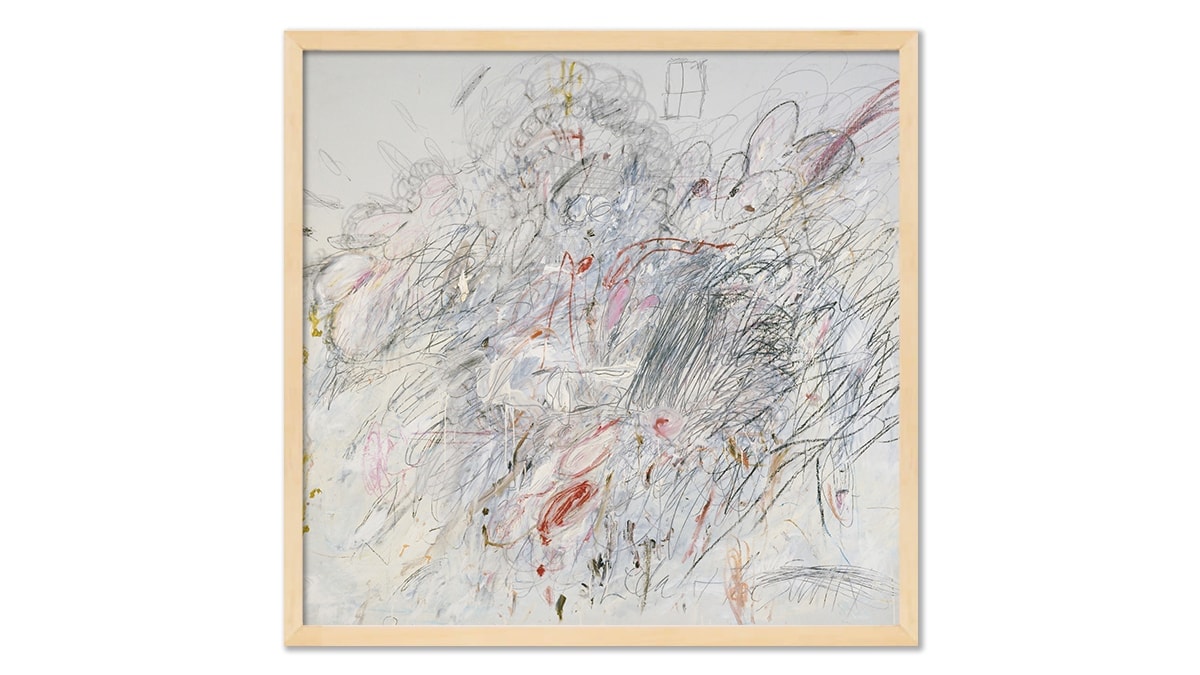
Cy Twombly gave birth to this famous abstract masterpiece in Rome, which was his hometown, in 1962.
The artist used crayons, ruddy paint, and pencil to vigorously paint his idea of the famous poem, “Leda and the Swan.”
Among the other elements of the painting, the fly, the heart, and the explosion are the most notable pieces of this painting that gained recognition among other artists.
The artist also used precise strokes to create the window and the surroundings, which gives the painting a child-like feeling.
The audience of this painting gets overwhelmed by the fusion of the energy explosion.
| Artist | Cy Twombly |
| Date of Creation | 1962 |
| Dimensions | – |
| Location | The Museum of Modern Art in New York |
31. Peinture (Etoile Bleue) (1963)
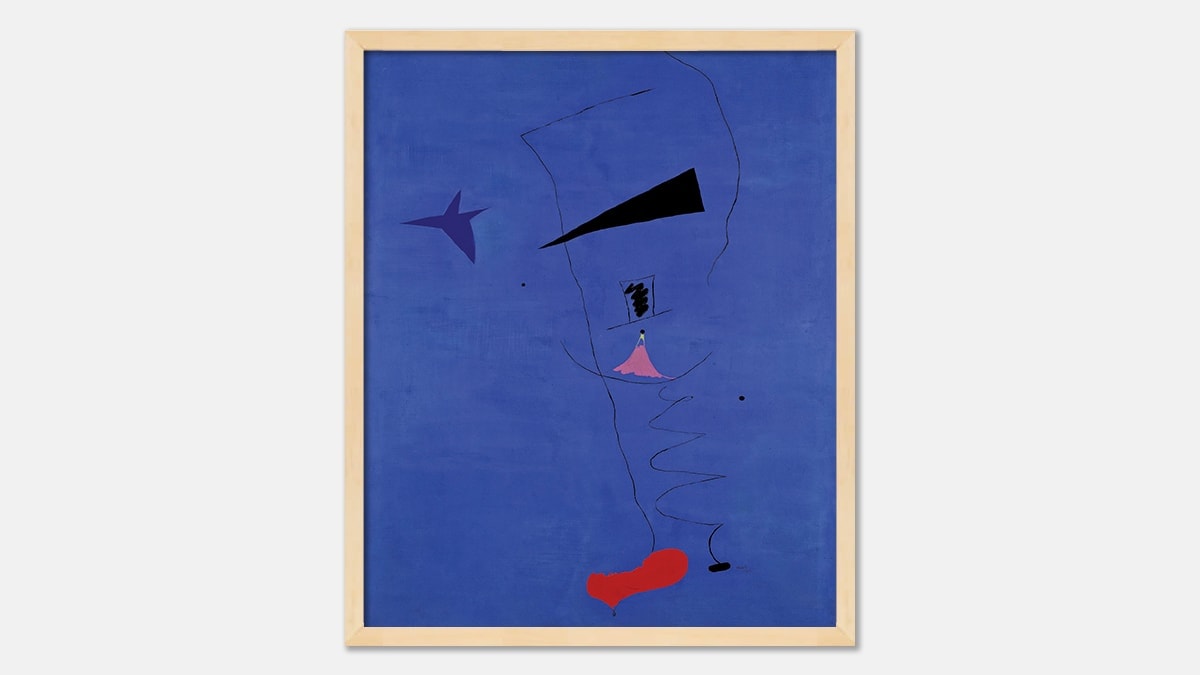
This world-renowned artwork is another of Joan Miro’s “Dream Painting Cycles.”.
The name Peinture (Etoile Bleue) means “Painting” (Blue Star).
The canvas is completely enveloped in azure color, with little elements of intricate linework and objects from his dreams.
After its exhibition, it would inspire famous abstract artists’ paintings like “Orange and Yellow” by Mark Rothko and encourage him to indulge in abstract art as well.
When it was auctioned in 2012, it fetched a world record price of $23.5 million, which was three times more than what it was sold for five years ago.
We can’t have this list without mentioning a similar work, which is also in a league of its own.
| Artist | Joan Miró |
| Date of Creation | 1927 |
| Dimensions | 115.5 x 89 cm |
| Location | Private Collection |
(Also Read: Colors in Art)
32. Triptych Bleu I, II, III
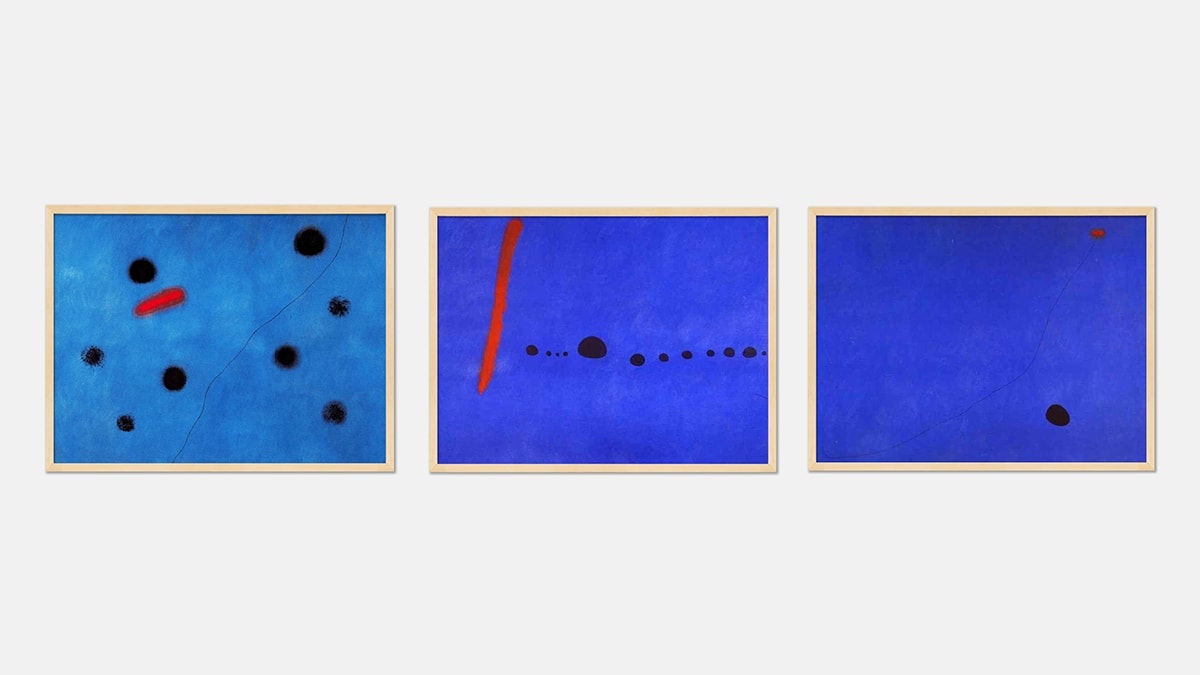
Triptych Bleu I, II, III is a three-piece compilation of Joan Miro’s famous abstract paintings called Bleu-I, Bleu-II, Bleu III.
Almost all of the painting is monotonously covered with azure blue.
The only exceptions are the blotches of black and red, which can be seen traveling diagonally through the triptych.
At the end of each series of black contours, a red symbol is perfectly placed, which makes the viewer dive into the depths of the deep blue color used in the background.
Most artists believe that these are reminiscent of his older series of dream paintings, which makes them one of the most famous abstract paintings by Joan Miro.
| Artist | Joan Miro |
| Date of Creation | 1961 |
| Dimensions | 270 cm × 355 cm |
| Location | Musée National d’Art Moderne |
33. No.5 (1962)
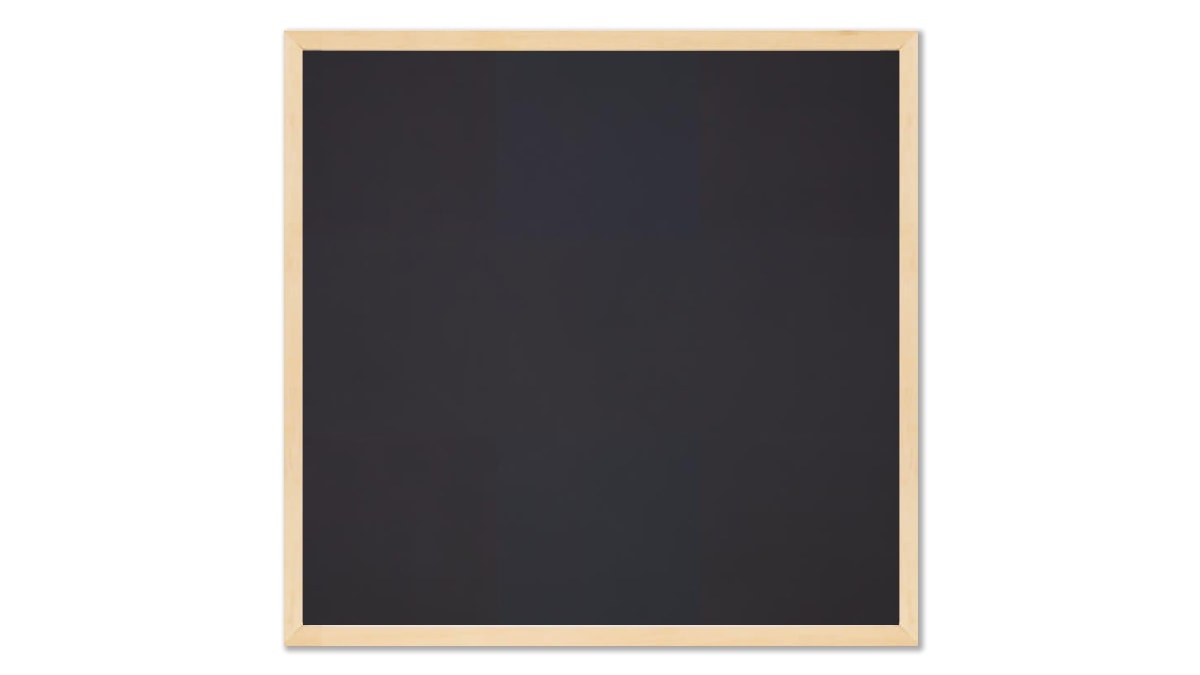
Although appearing to be one color, Ab Reinhardt has used three distinct shades of black.
But the use of just one dark color makes it unique and one of the most famous abstract paintings.
When he was asked about this painting, he said, “There is a black that is old and a black that is fresh.”
“Lustrous black and dull black, black in sunlight and black in shadow.”
The whole canvas is divided into three parts, with each part having a hint of red mixed with black.
This classic abstract painting was greatly influenced by the abstract and minimalist artists of the 60s.
It also makes it one of the most famous minimalist paintings in the world.
Unfortunately, it was also his last painting.
| Artist | Ab Reinhardt |
| Date of Creation | 1962 |
| Dimensions | 152.4 cm x 152.4 cm |
| Location | Museum of Modern Art in New York City |
34. Elegy to the Spanish Republic (1967)
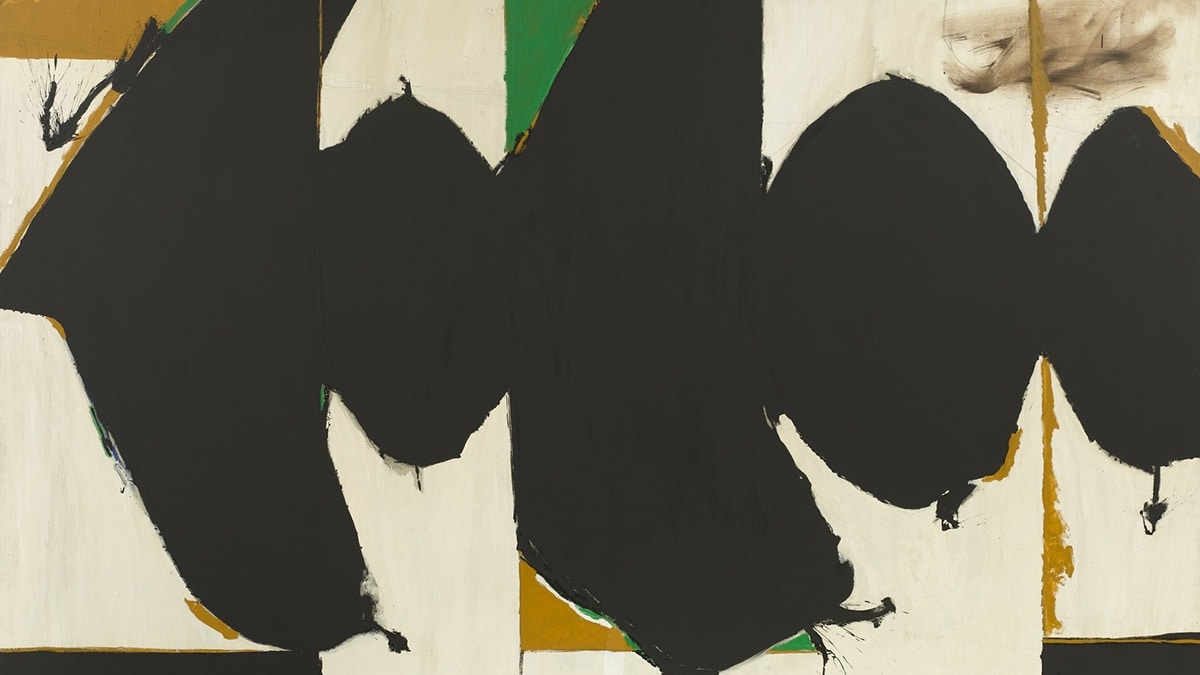
Robert Motherwell painted this abstract painting as a “lamentation or a funeral song” after the Spanish Civil War.
The main subjects of this painting are the black oval blocks that appear one after another throughout the whole artwork.
The message that they send is about something that is void of color and not a hole.
The reason for this is that the pattern describes the cycle of life and death.
Which was in accordance with Motherwell’s principles of surrealism and automatism.
The famous abstract artist described his elegies as a “private insistence that a terrible death happened that should not be forgotten.”
After it was released, it received positive reviews from the artists, as it stood for the suffering and loss of people.
| Artist | Robert Motherwell |
| Date of Creation | 1967 |
| Dimensions | 208.2 cm x 351.1 cm |
| Location | The Museum of Modern Art in New York City. |
35. 180 Farben (1971)
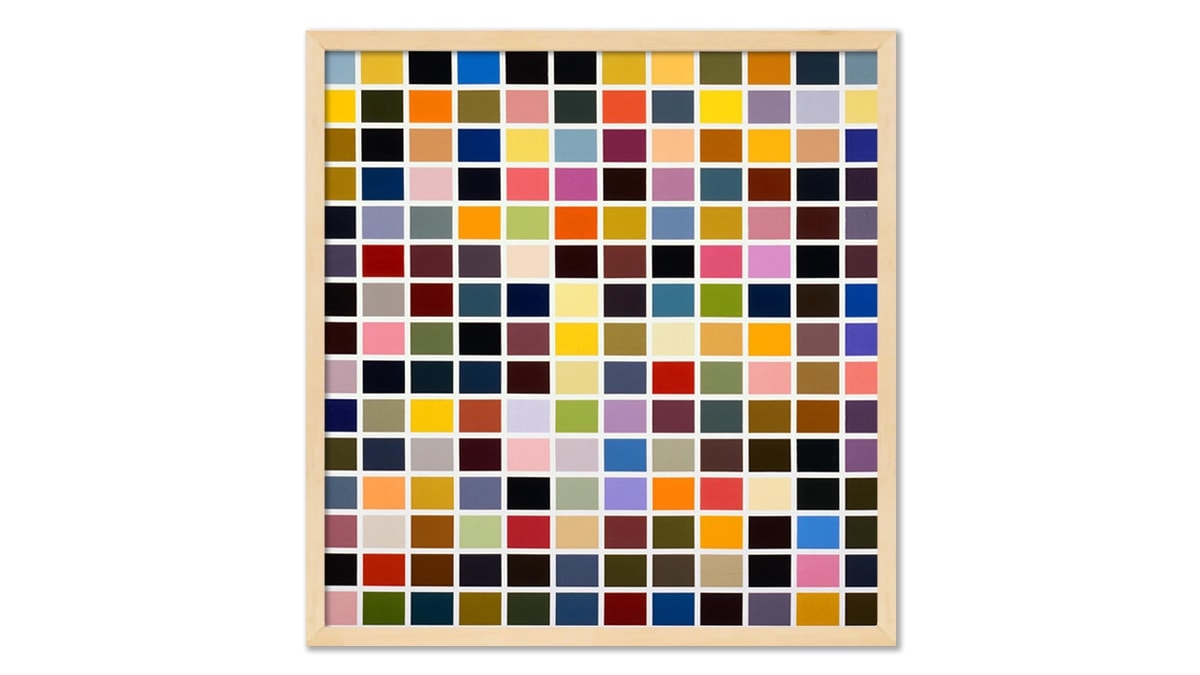
Gerhard Richter’s 180 Farben, or 180 colors, was made to promote the right to choose.
Providing the three primary colors and then mixing fifteen hues. with each to create a shiny, dark, and glowy variation, resulting in these 180 variations of color.
The artist then painted these variations as blocks onto a 6-foot 6-inch tall square canvas.
After spending a long time with this famous abstract artwork, the viewer is said to have feelings of curiosity, aspiration, and desire instilled in them.
It is now housed at the Philadelphia Museum of Art.
| Artist | Gerhard Richter |
| Date of Creation | 1971 |
| Dimensions | 200 cm × 200 cm |
| Location | The Philadelphia Museum of Art |
36. On A Clear Day (1973)
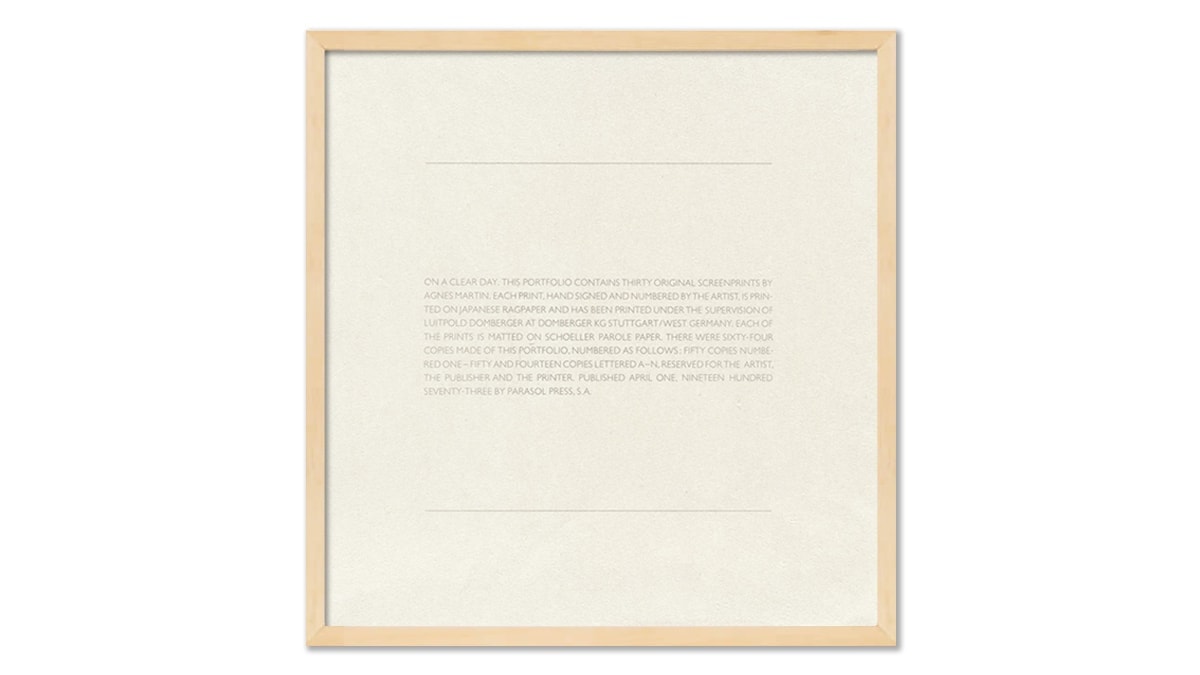
On A Clear Day was one of 30,12-inch x 12-inch printworks made by Agnes Martin.
It is said that after achieving great success in the United States, the artist left everything to settle down in isolation in New Mexico.
After six years, Agnes reintroduced herself into the art world through these well-known prints.
The main subject of this artwork is the square grid that the print forms on the paper.
This square grid was the signature style of Agnes’s style.
The viewer is said to initially perceive a variety of expressions from the grid of words.
But the main expressions that the artist wanted to strike were the innocence of the mind and the subtle moments of happiness, beauty, and freedom.
The 30 prints indicate the days in the month or the passage of time.
All its prints now share a wall at the Museum of Modern Art, New York.
| Artist | Agnes Martin |
| Date of Creation | 1973 |
| Dimensions | 30.8 × 30.5 cm |
| Location | The Museum of Modern Art, New York |
37. Juin-Octobre (1985)
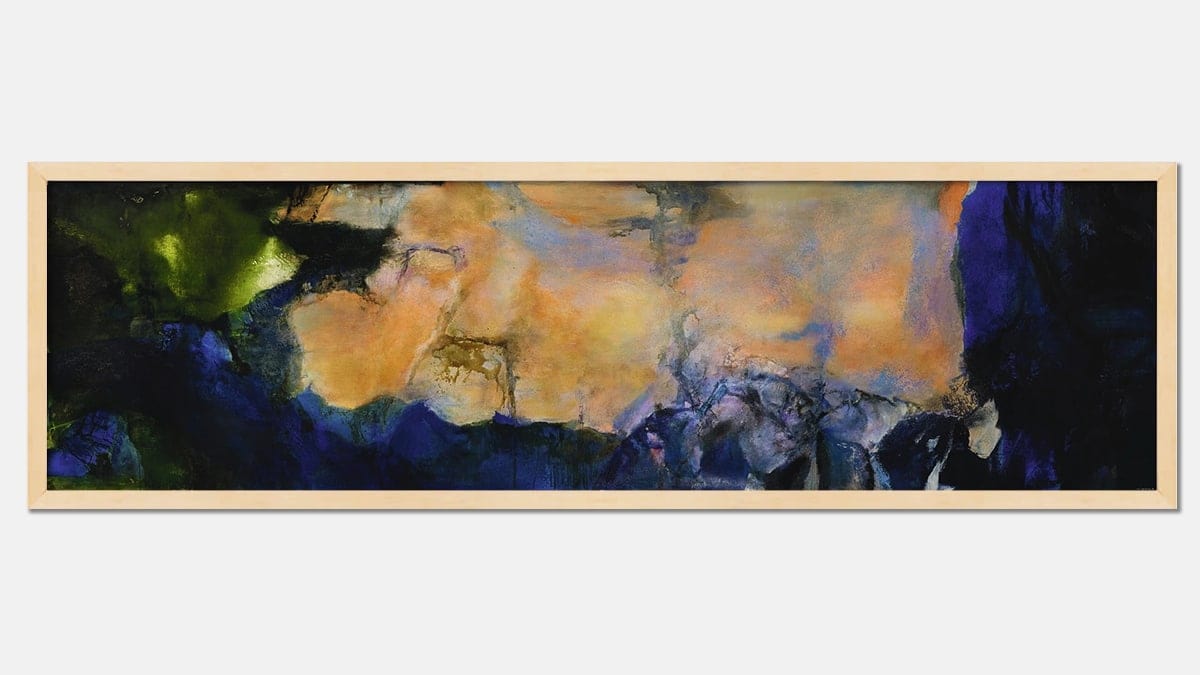
The famous Chinese abstract artist, Zou Wou-ki, is the father of this gigantic wall abstract painting.
It was commissioned by the famous Chinese architect, I.M. Pei, to add beauty to the Raffles City Complex in Singapore.
This abstract wall art is painted with luscious light green on one side and beautiful aqua blue on the other.
The centerpiece features clever use of the colors yellow and white to give the viewer an amber experience.
The artwork was then converted into a triptych, making it a final compilation of three distinct pieces.
| Artist | Zou Wou-ki |
| Date of Creation | 1985 |
| Dimensions | – |
| Location | Private Collection |
38. Abstrakte Bild 809-1 (1994)
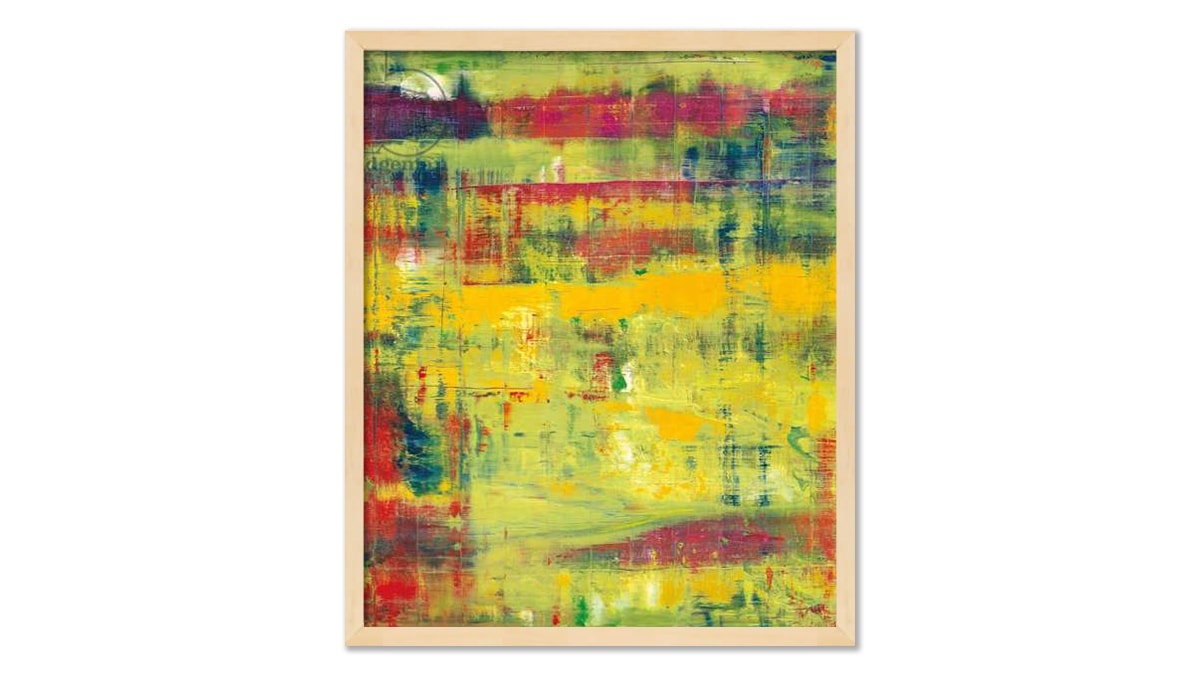
One of the most expensive paintings made by Gerard Richter, Akstrate Bild 809-1, is unique in its own way.
The artist had added layers upon layers of paint to an already-painted canvas and then dragged the wet paint down with a squeegee on either side.
After the layer dried, Gerard had used the same canvas and added another layer to it to add depth.
Once the viewers started spectating it, the layers began to dissolve in his mind, unfolding a new sensation at every corner.
It is rumored that the way the colors came out on the canvas was completely different from what the artist had imagined them to be.
| Artist | Gerard Richter |
| Date of Creation | 1994 |
| Dimensions | 225 cm x 200 cm |
| Location | Private Collection |
(Suggested: Color in Art Explained)
39. Small flies and Other Wings (2013)
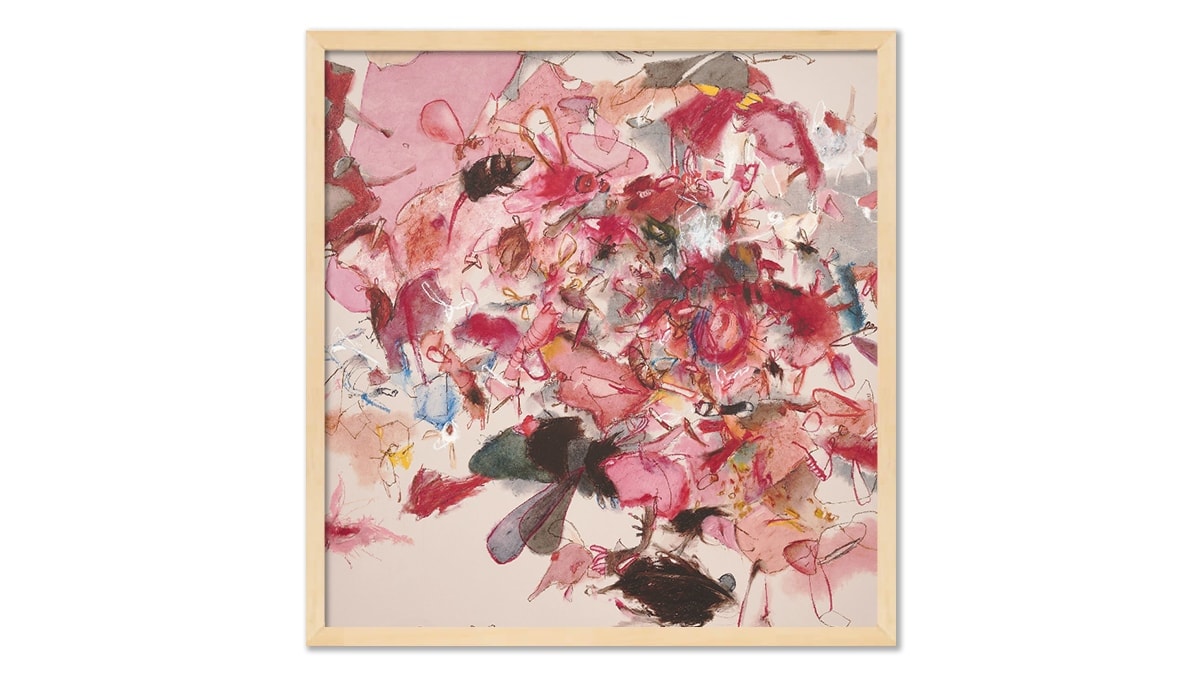
Without a doubt, it’s the most mixed-up subject artwork, which was recorded as Christina Ay Tjoe’s most popular abstract art.
Many artists left various comments on Christina’s use of colors; the most prominent one was that its shades are intriguing and inviting.
This is perhaps because of the bland background, which contrasts beautifully with the pink and makes it pop.
At first glance, the canvas takes the viewer all across the subjects, until the viewer realizes that the spectacle is a graveyard of small flies overlapping each other.
| Artist | Christina Ay Tjoe |
| Date of Creation | 2013 |
| Dimensions | 165.3 x 150.5 cm |
| Location | Private Collection |
40. Slit (2020)
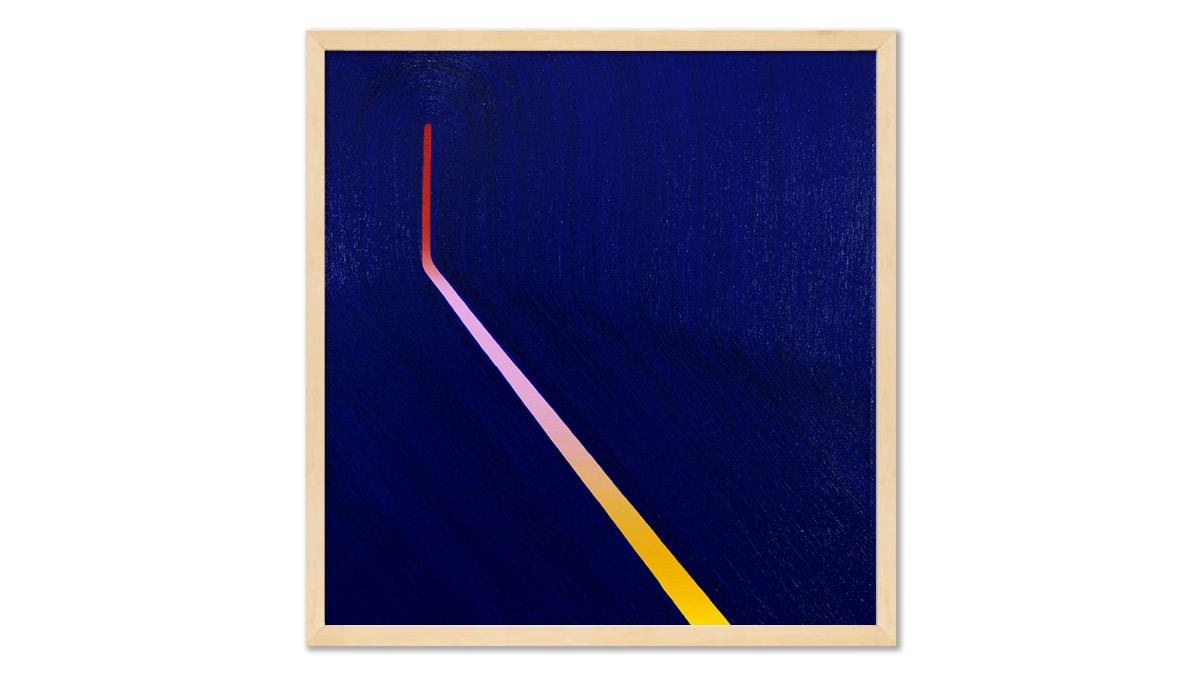
An up and coming abstract artist, Osamu Kobayashi, painted Slit with a playful geometry in mind.
The dark hues of the background make the actual subject stand out, garnering every viewer’s attention.
Because of his use of shades of bright yellow, this artwork received great recognition from artists and also marked the beginning of an era of modern abstract painting.
It was sold to a private collector for an unknown amount after it was made.
| Artist | Osamu Kobayashi |
| Date of Creation | 2020 |
| Dimensions | 45.7 cm × 40.6 cm |
| Location | Private Collection |
Surrealism, De Stijl, and abstraction are the three pillars of this artistic movement.
The core ideology of them is to be fearless and vocal about your belief system, not to be behind because of any external force.
Abstract artists would break stereotypes and express themselves through weird colors, intricate designs, and complex patterns, making their audience linger and connect with their abstract paintings.
Well, you must have learned that through various examples of famous abstract art, which, of course, would have ignited your curiosity.
If the above-listed artworks have ignited your curiosity and made you fall for art even more, then why not get yourself a replica of these famous abstract paintings?
Heya readers,
Thank you for reading this article all the way to the end.
If you have questions or useful facts to add to it, don’t hesitate to use our comments section.
Make sure to give us a follow on our Instagram page and subscribe to our YouTube channel.
Don’t worry; your journey in the world of art hasn’t ended yet.
We’ve a lot to offer—be it art-related blogs or portraits, which are unique in their own way—for instance, you can have a portrait made, which has the same theme, color, and feel as renowned paintings.
Check out this page—art transfer from photos, and paint yourself in an iconic style.
FAQs
An artwork that does not aim to achieve an accurate depiction of reality while portraying its subjects.
Suprematist Composition (1916) was sold for $85.8 million and is regarded as the most expensive abstract artwork by Kazmir Malevich.
No. 5 by Jackson Pollock is the most expensive abstract painting in the world. It was sold for 140 million dollars.
Mark Rothko, Jackson Pollock, and Georgia O’Keeffe are some of the most famous abstract artists in the USA.
Some of the most famous abstract artists active today are Osamu Kobayashi, Loie Hollowell, and Manuel Mathieu.
Wassily Kandinsky’s Composition X is regarded as the most famous abstract line art ever made.
Senecio is Paul Klee’s most famous abstract painting.
Composition VII, Composition X, and Improvisation 31 are the best abstract artworks by Wassily Kandinksy.

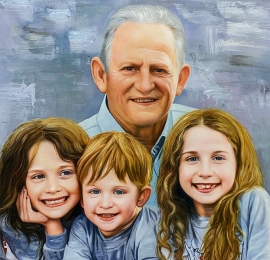
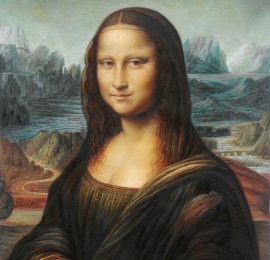
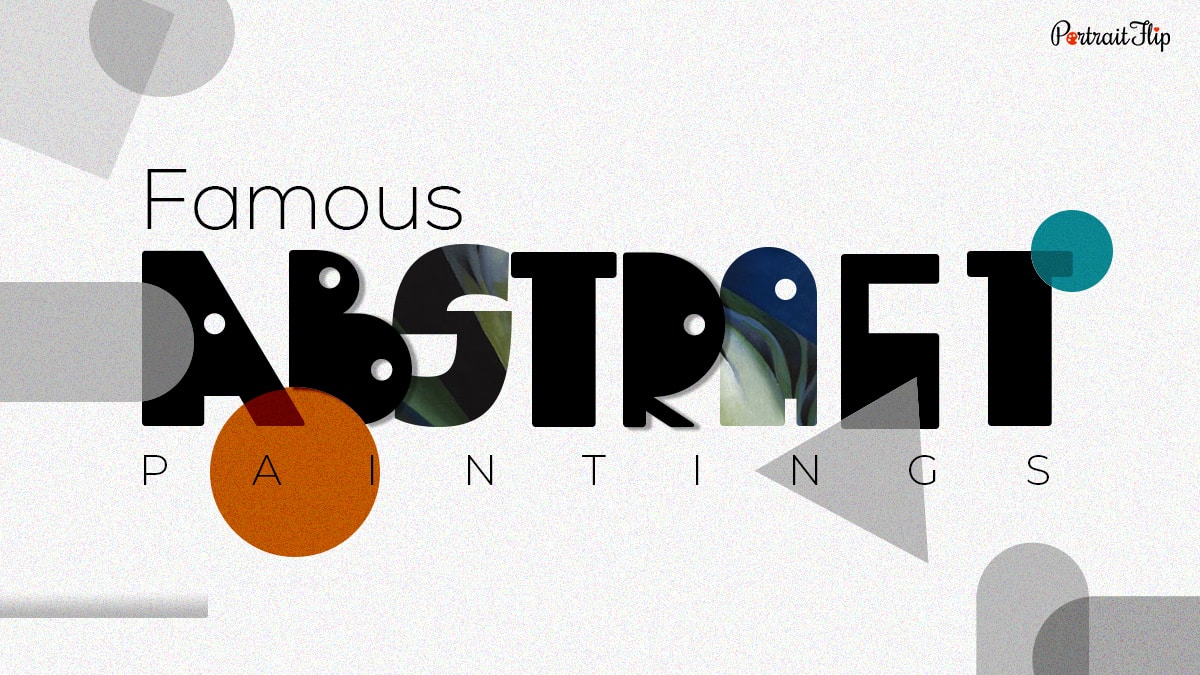
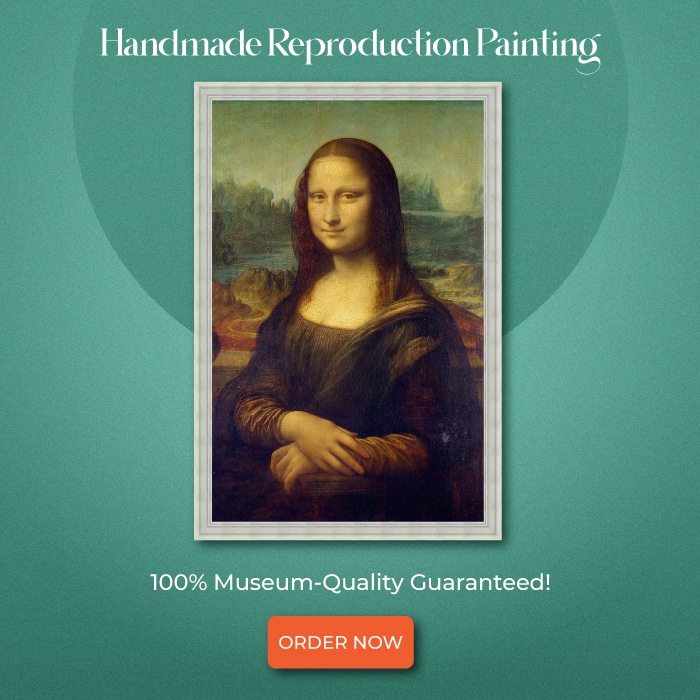
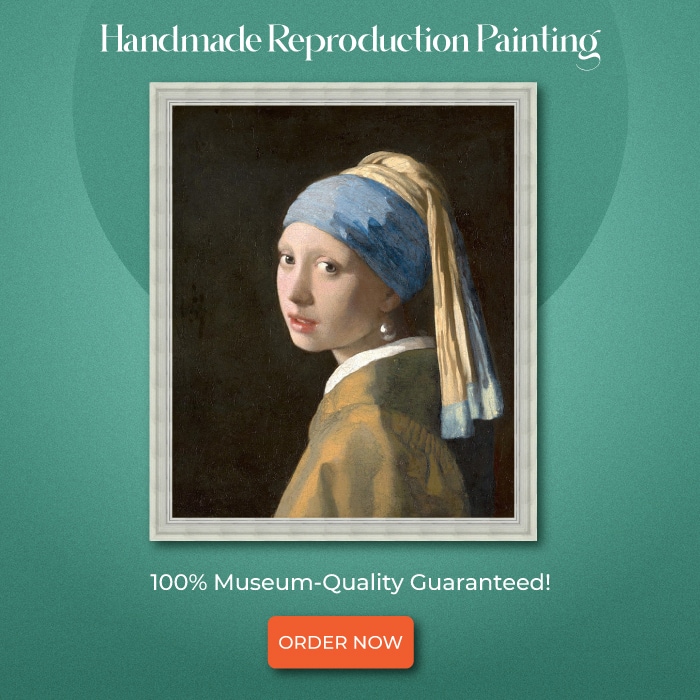

Pingback: 70+ Ideas For Bedroom Wall Décor That Will Transform A Blah Space
Good job covering a broad range of abstract paintings over the years. “Slit” looks like the light shining when a door is cracked open.